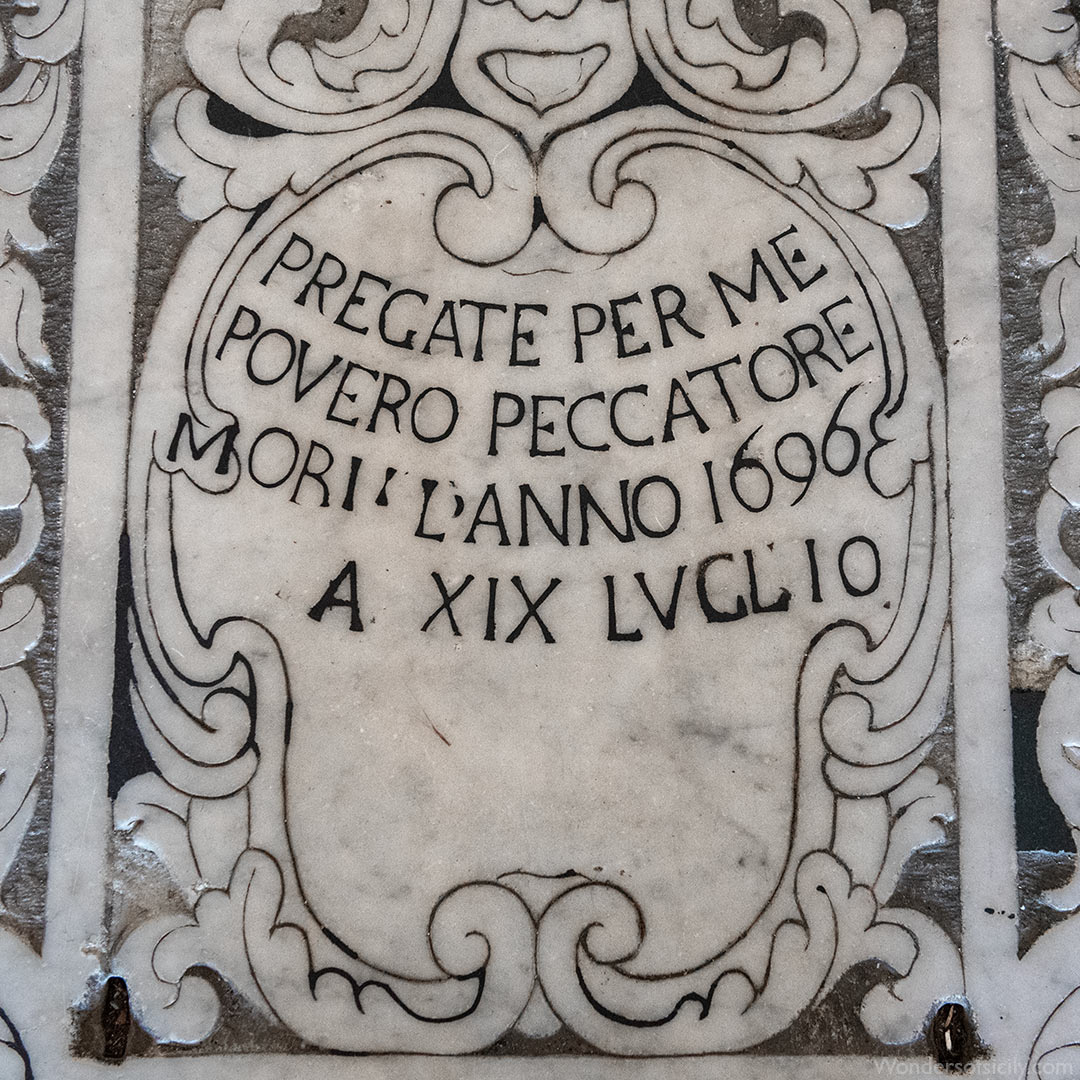Churches in Sicily
Chiesa di San Francesco d’Assisi
Photos of some of the most interesting Norman and baroque churches in Sicily.
Siracusa
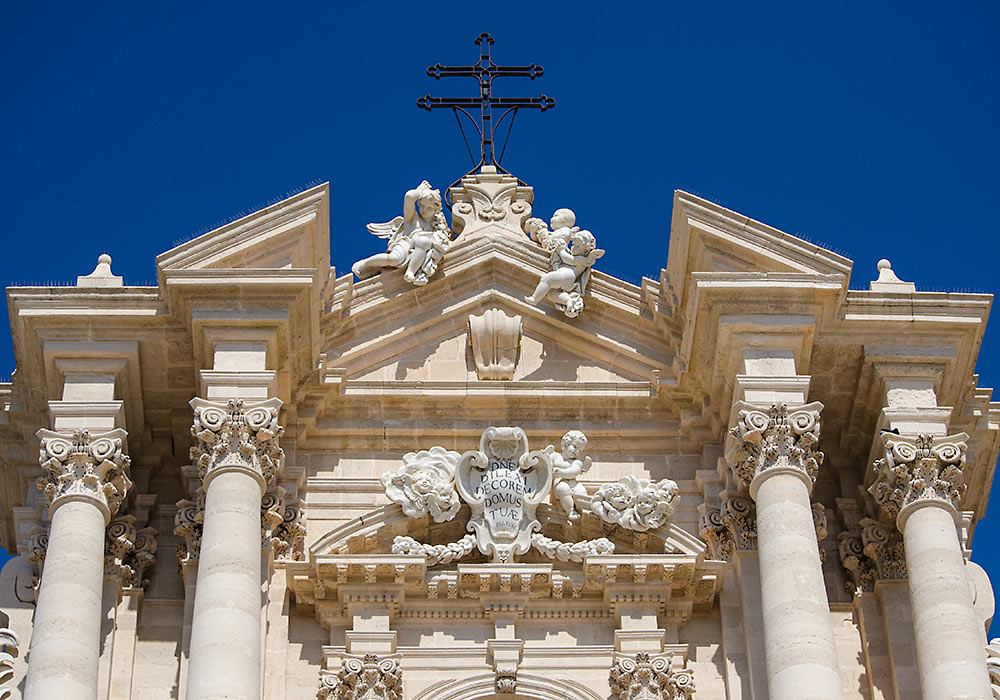
The facade of the Cathedral in Siracusa, a powerful Sicilian-Baroque composition erected in 1728-54. It was designed by Andrea Palma.
On 11 January 1693 Sicily was struck by an earthquake destroying more than 70 cities and killing 60.000 people. As a result of the earthquake in 1693, whole cities had to be rebuilt. In Val di Noto (Noto Valley), many of the Baroque cities have been included on the UNESCO World Heritage List. In the justification, UNESCO writes: "The exceptional quality of the late Baroque art and architecture in the Val di Noto lies in its geographical and chronological homogeneity, as well as its quantity, the result of the 1693 earthquake in this region."
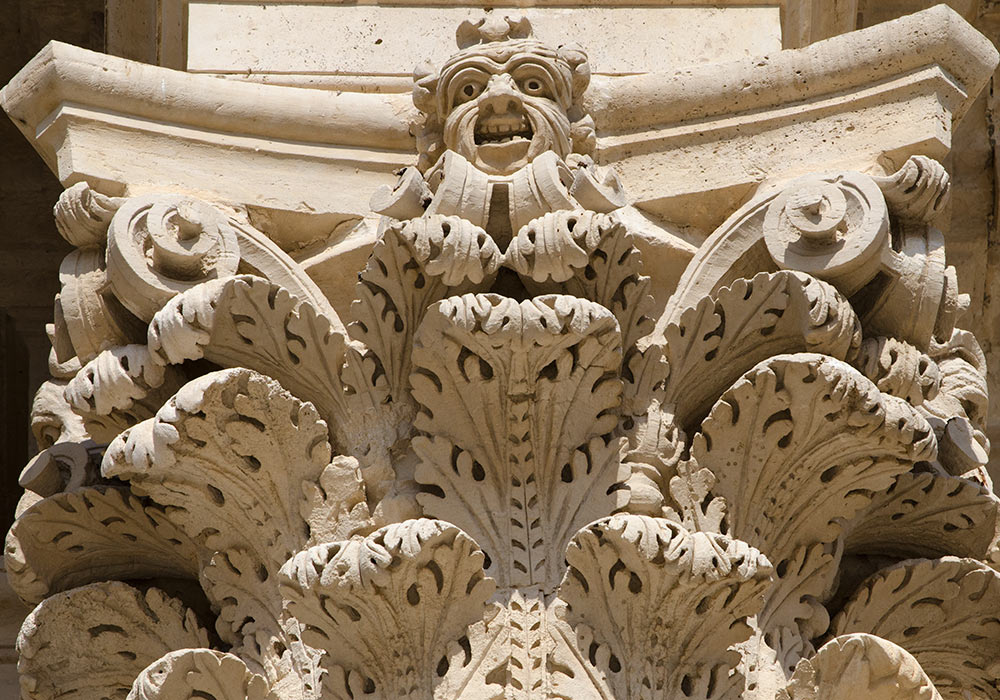
Detail of the ornaments of the baroque cathedral in Syracuse.
The cathedral in Syracuse
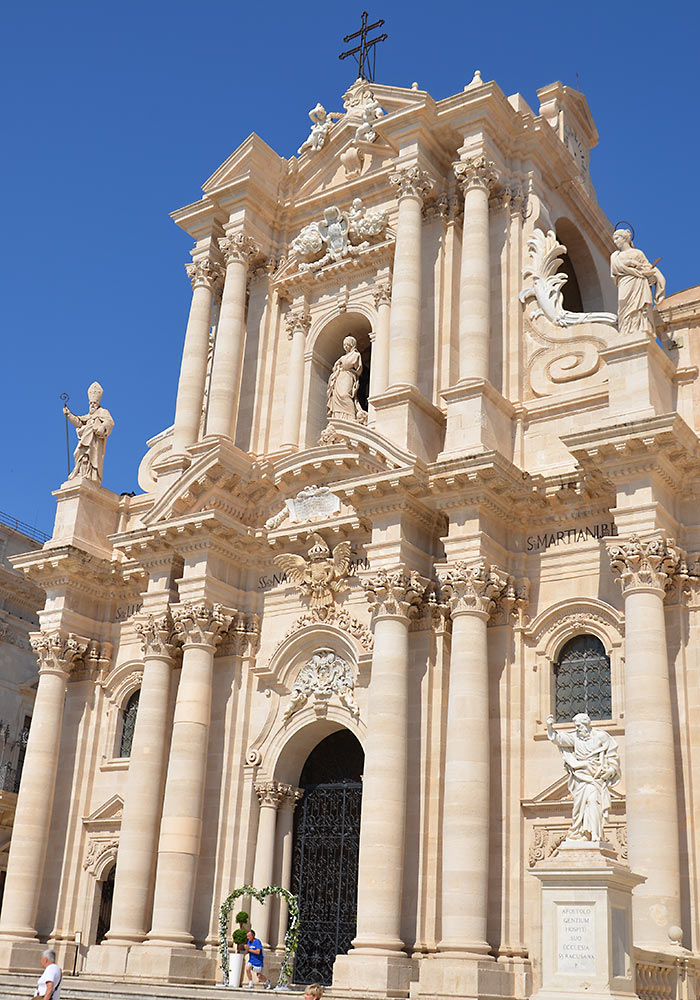
The cathedral in Syracuse.
Photo: Torild Egge
La chiesa di Santa Lucia alla Badia
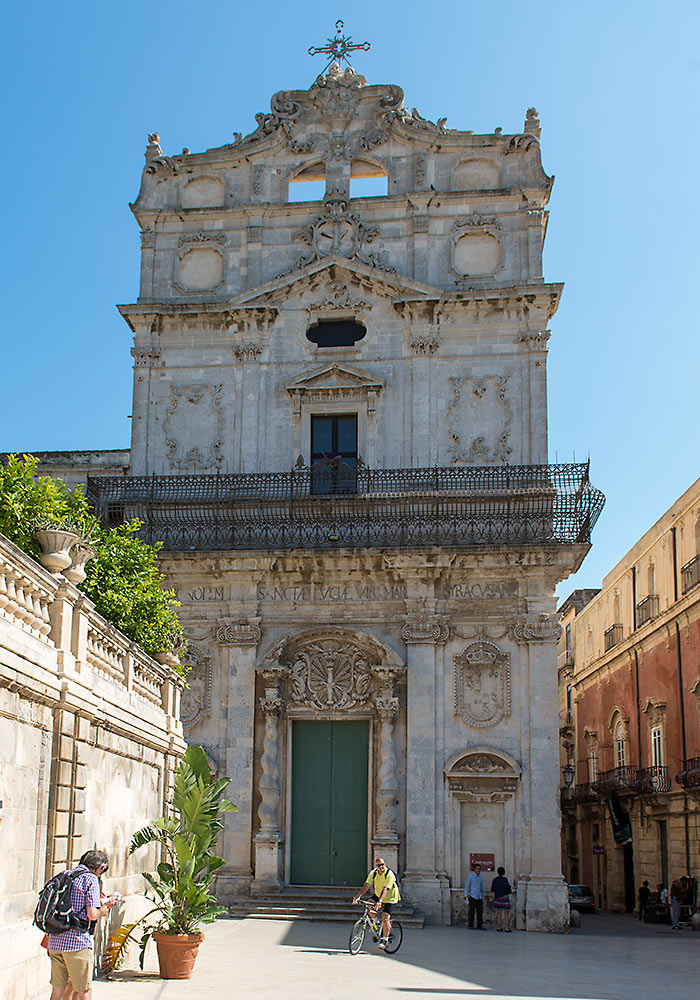
The church of Santa Lucia alla Badia (La chiesa di Santa Lucia alla Badia) is located on the south side of Piazza Duomo. The Bavarian-baroque facade from 1695 is made of Luciano Caracciolo. Inside the church there is a very famous painting by Caravaggio (St. Lucia's funeral).
Related links
- Depictions of Jesus (as Christ Pantocrator) in Sicily
- The Monreale Cathedral
- The Cefalù Cathedral
- Mosaics in Sicily
- Churches in Sicily
Churches in Palermo
Santo Spirito
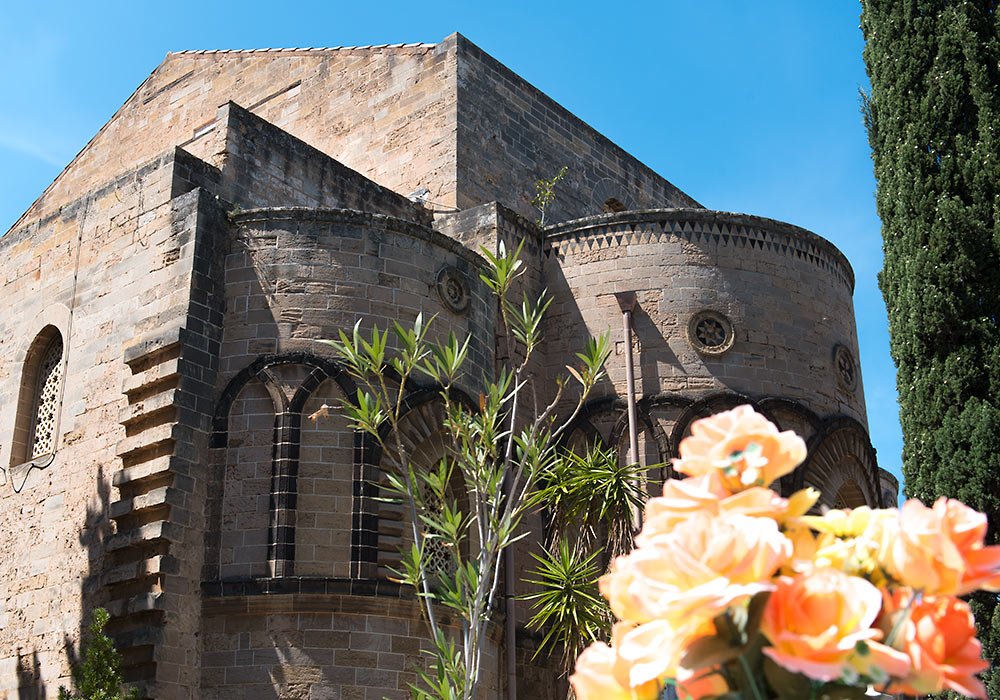
The Norman church Santo Spirito.
La Martorana (Santa Maria dell'Ammiraglio), Palermo
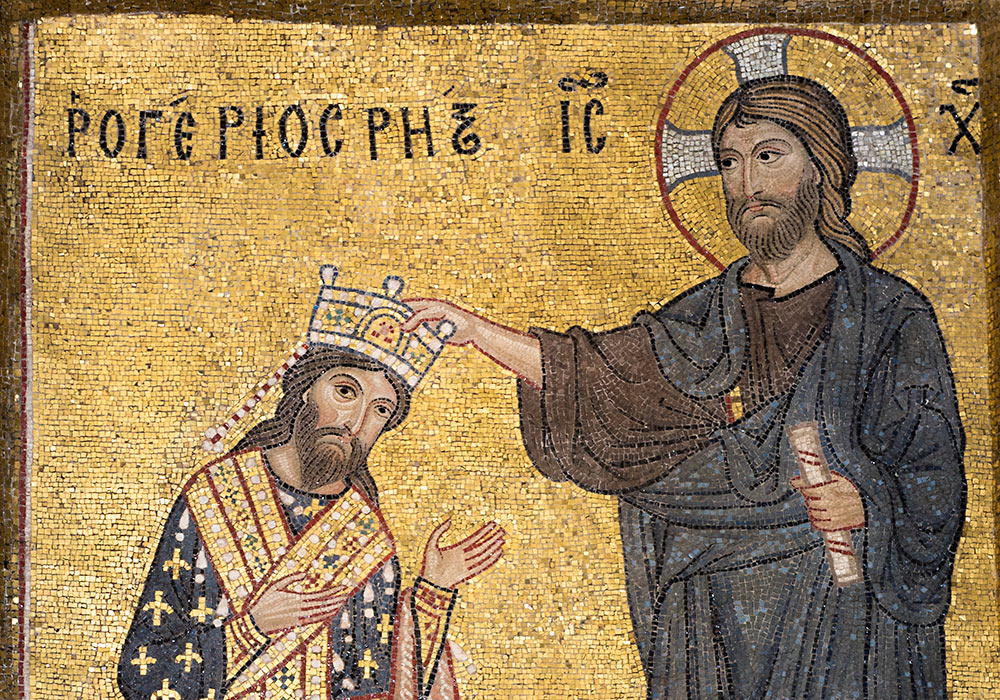
Roger II receiving the crown directly from Christ and not the Pope. Mosaic in the Martorana, Palermo. The mosaic carries an inscription Rogerios Rex in Greek letters. After the Sicilian Vespers of 1282 the island's nobility gathered in the church for a meeting that resulted in the Sicilian crown being offered to Peter III of Aragon.
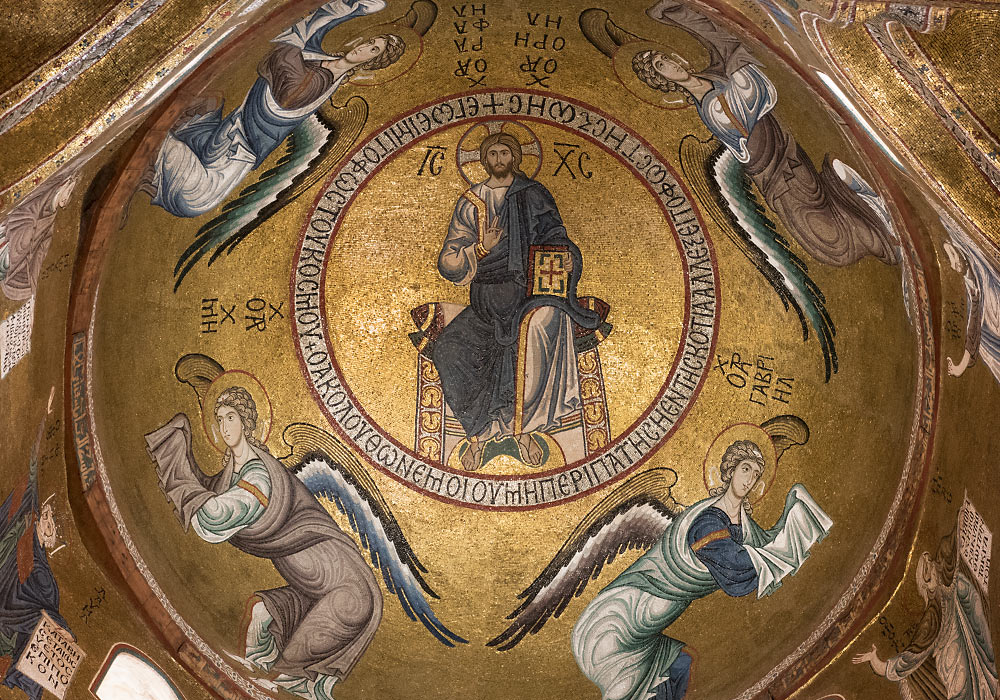
Christ Pantocrator in Martorana (Santa Maria dell'Ammiraglio), Palermo. The 12th century mosaics were executed by Byzantine craftsmen.
The Church of the Gesù (Casa Professa), Palermo
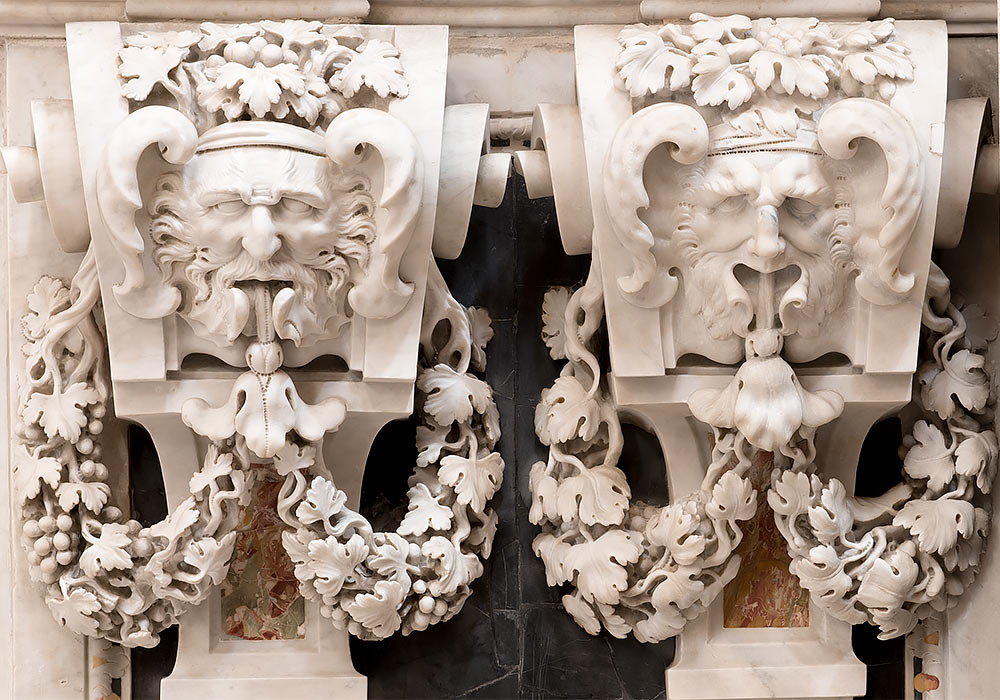
The marble reliefs with their figural and ornamental motifs in the Jesuit Church of the Gesù are unique.
The Church of San Domenico
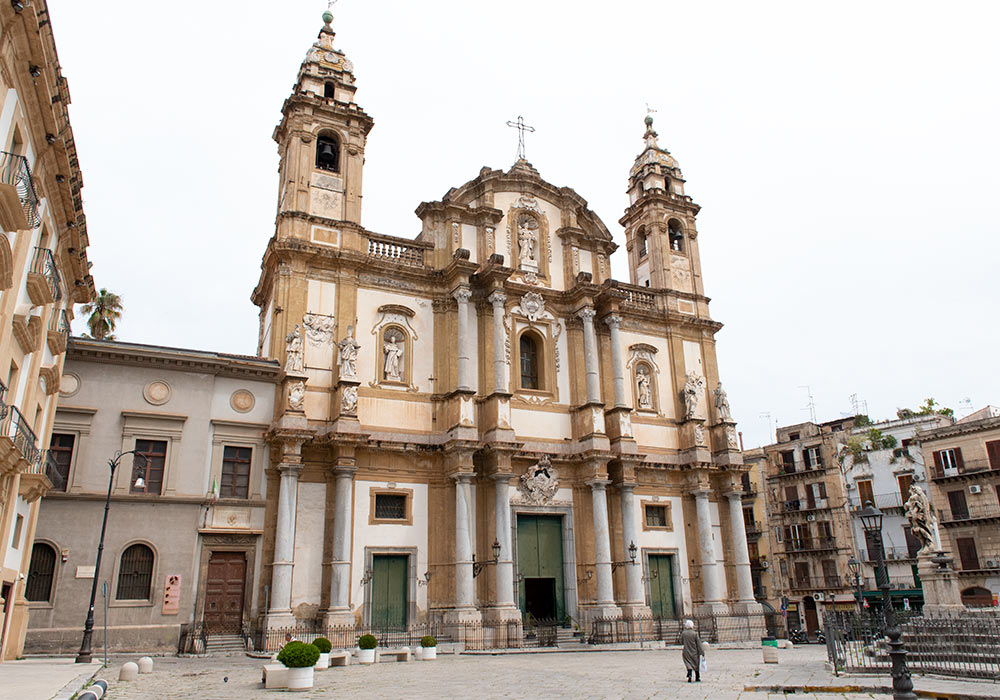
The large church of San Domenico in Piazza San Domenico was rebuilt in 1640 but the imposing facade was made in 1726.
See more photos of San Domenico here...
Chiesa di San Francesco d’Assisi
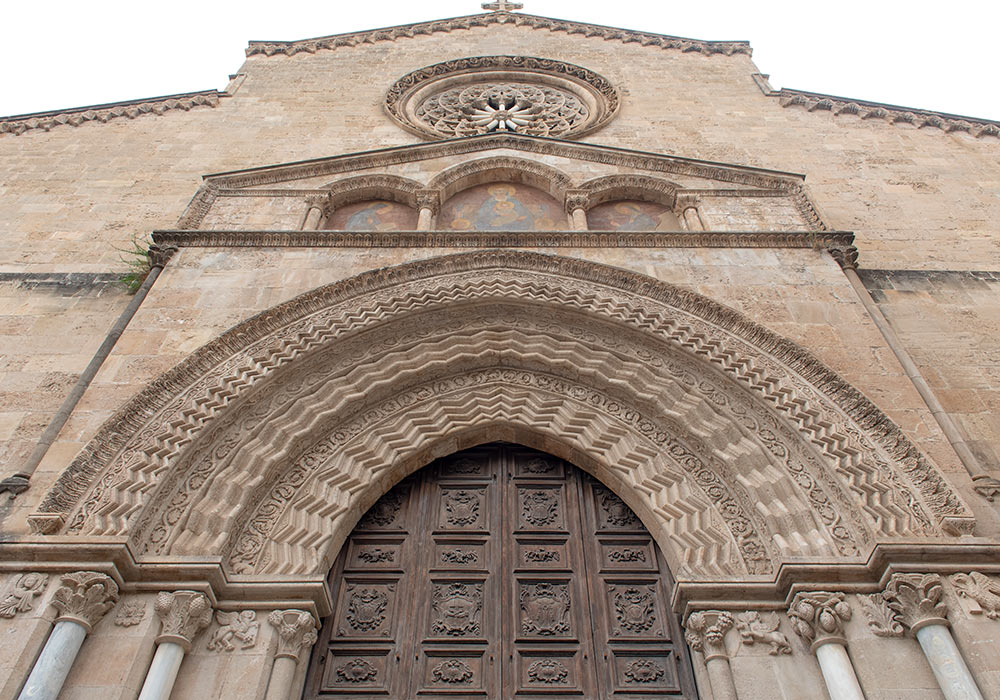
The magnificent portal (1302) and rose window of Chiesa di San Francesco d’Assisi. The church was damaged by an earthquake in 1823 and during air raids in 1943. After the Second World War it was restored.
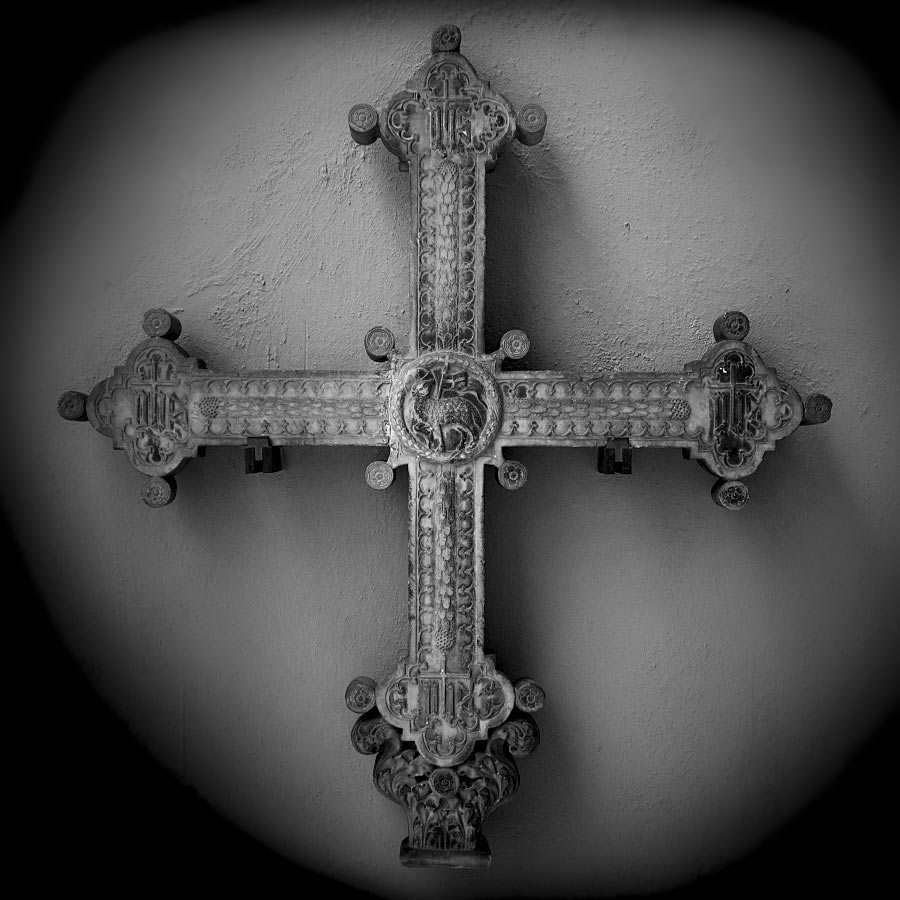
Cross (second half of 15th century) from Chiesa di San Francesco d’Assisi, Palermo. Now in Galleria Regionale della Sicilia, Palazzo Abatelli (the Gallery of Art for the Sicilian region).
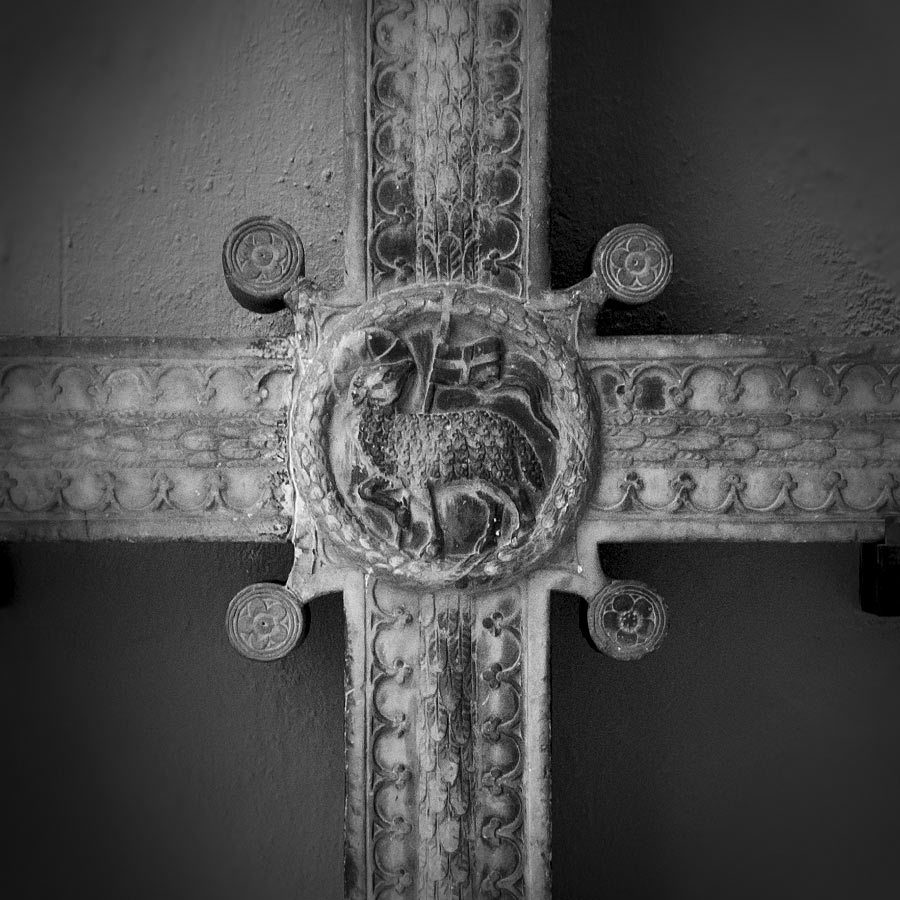
Detail of Christ as the Lamb of God (Agnus Dei), center of cross (second half of 15th century) from Chiesa di San Francesco d’Assisi, Palermo. Now in Galleria Regionale della Sicilia, Palazzo Abatelli.
Chiesa di Sant'Orsola, Palermo
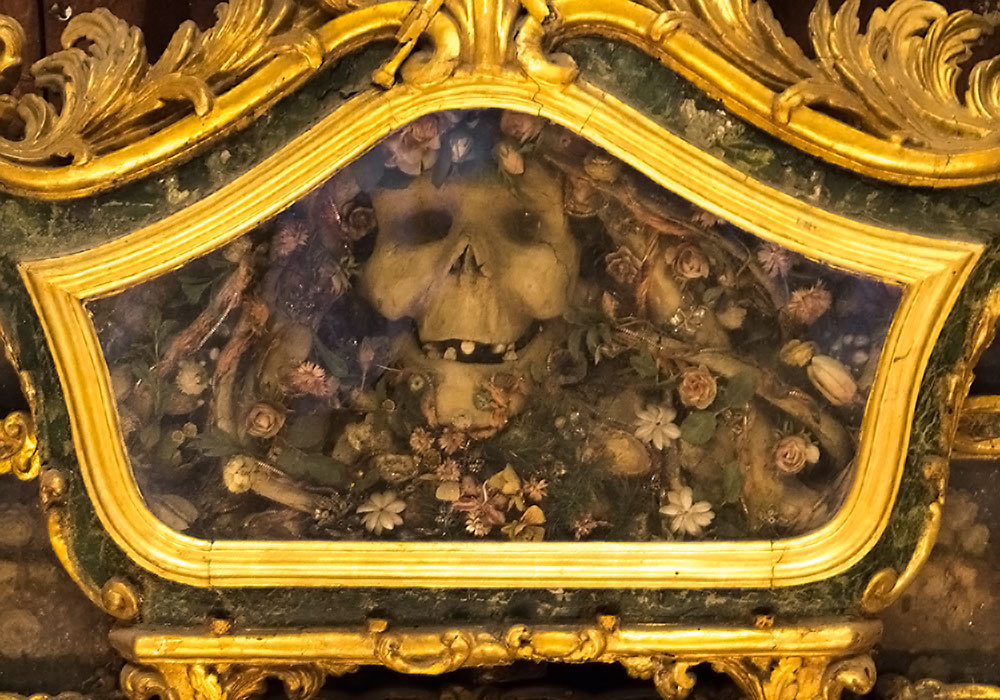
Detail of an altarpiece in Chiesa di Sant'Orsola dei Negri (Via Maqueda 152), Palermo.
Click here for more on death in Sicily.
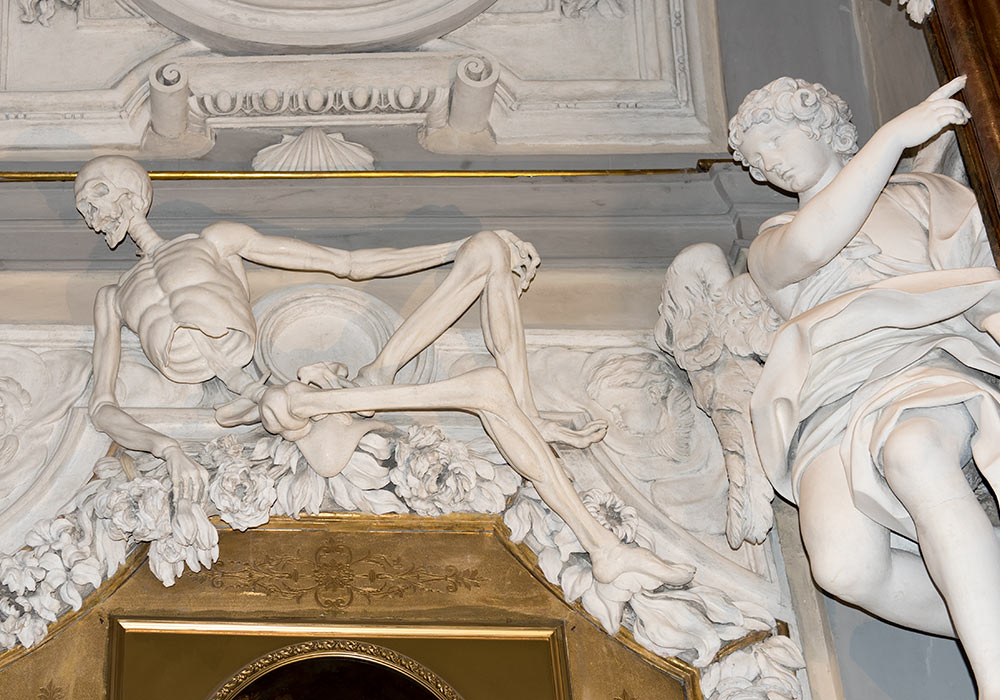
Stucci by Giacomo Serpotta in Chiesa di Sant'Orsola, Palermo.
Chiesa Santa Maria della Catena (Church of Saint Mary of the Chain)
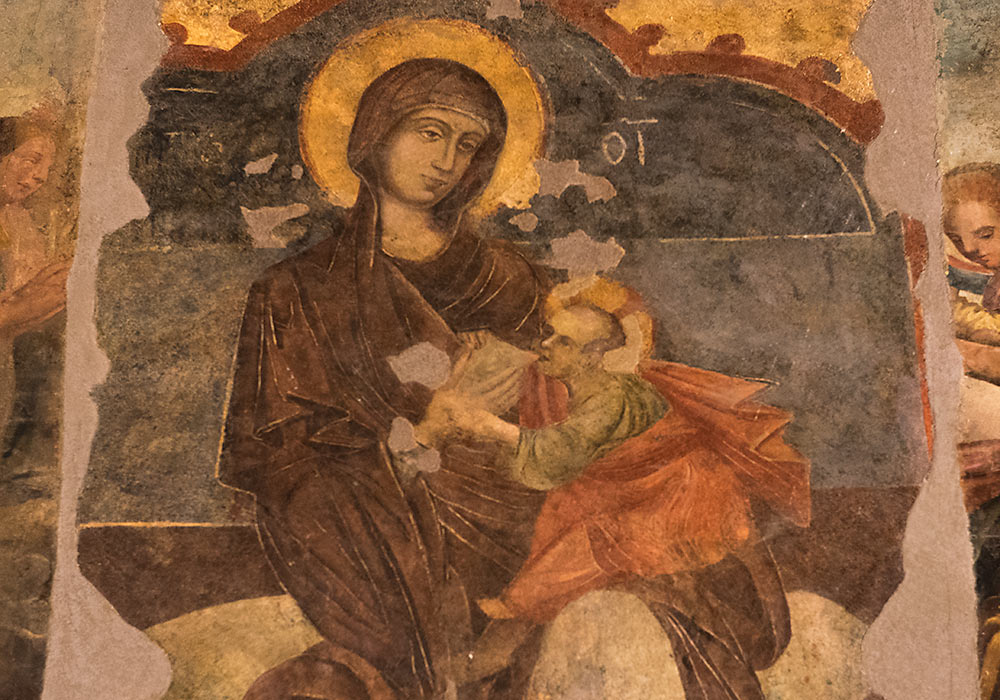
A painting of Mary with the child Jesus at her breast is found in Chiesa Santa Maria della Catena (Church of Saint Mary of the Chain) close to Porta Felice in Palermo. Jesus is depicted as an adult and Mary's breast is exposed. The painting was later censored and painted over. It has now been restored, but you can see the new painting to the left and the right of Maria and Jesus.
Chiesa di S. Ninfa dei Crociferi
Although far from finished, the Church of S. Ninfa dei Crociferi opened on 30 December 1660.
Saint Ninfa (English: Nympha) was a virgin from Palermo, where she (most likely) lived in the early 3rd century.
One version of the legend tells that Ninfa was the daughter of Aurelian, the prefect of Palermo during the time of Emperor Constantine the Great (306–37; sole emperor from 324). Ninfa converted to Christianity, and a key factor in this decision was her meeting with Bishop Mamilian of Palermo and their conversations. Prefect Aurelian would do anything to pull his daughter away from the new religion, so he arrested Bishop Mamilian and two hundred other Christians. However, his attempts were in vain, and after the Christians endured torture, they were thrown into prison. Ninfa was with her new fellow believers. An angel freed them and led them to the sea, where they found a boat that took Mamilian and Nympha north to the island of Giglio off the coast of Tuscany, where they remained in prayer and solitude.
They were eager to visit Rome and the graves of the Apostles. After visiting the apostles’ graves, Mamilian died, and Ninfa buried him near Bucina. After about a year, Ninfa also died on November 10, 316, and was buried at a site where the remains of other martyrs were preserved (thus, she was believed to have died as a martyr). The Christians of the area called upon her during a drought, praying for her intercession for rain. The long-awaited miracle occurred, and the faithful began to honor her as a saint.
Another version of the legend, however, states that Ninfa lived in the 4th century, and when the Goths invaded Sicily, she fled to the Italian mainland and died a natural death in Savona, Tuscany, in the 5th century. Some believe there were two different saints—one a martyr and the other a confessor.
The earliest mention of Ninfa is from the 8th century, when it is noted in the biography of Pope Leo IV (847–55) that he donated a gift to the church of Santa Ninfa Martire, located in Porto near Rome. Her relics were kept alongside those of Saints Tryphon and Respicius in the hospital of Santo Spirito in Sassia, not far from St. Peter's Basilica in Rome. This hospital’s church was the titular church for a cardinal, but this title was transferred in 1566 to the church of Sant’Agostino by Pope Pius V, along with the relics of these three saints.
Later, her relics were placed in various churches in Rome, including San Trifone near Piazza Fiammetta (1113), San Crisogono (1123), and the cathedral in Palestrina in the province of Rome (1116). In 1098, Pope Urban II (1088–99) placed her head in the Roman church of Santa Maria in Monticelli.
On September 5, 1593, a silver casket containing Ninfa’s head arrived in Palermo, her birthplace. The relic was ceremoniously received by the city’s senate before being placed under an altar in Palermo Cathedral, where she had been honored at least since 1483. The altar was consecrated in 1598.
The transfer of the casket from the Roman church of Santa Maria in Monticelli to her hometown was made possible through the efforts of the Countess of Olivares in the Vatican.
Her cult spread to other Sicilian cities, and the town of Santa Ninfa in the province of Trapani in Sicily bears her name.
Before 1624, Palermo had four patron saints, one for each of the four main districts of the city. These were Saints Agatha of Catania (ca. 225–ca. 251) (maybe born in Palermo), Christina of Bolsena (d. ca. 304), Ninfa, and Olivia of Palermo. Their statues can be found on the four houses around the Quattro Canti square in the center of Palermo. After the plague of 1624, which disappeared the moment the relics of Saint Rosalia of Palermo (d. ca. 1166) were carried in procession, she was then lovingly called "Santuzza" by all the people of Palermo. At that point, Agatha, Nympha, Christina, and Oliva stepped aside to allow Rosalia to hold the undisputed title of "patron saint of Palermo."
In the Martyrologium Romanum, revised by the venerable Cardinal Cesare Baronius (1538–1607), Ninfa was listed alongside Tryphon and Respicius on November 10, but with no specific location, as was already the tradition in the Roman Church. This was repeated in later editions of the martyrology, including the 1748 edition commissioned by Pope Benedict XIV (1740–58) and the 1913 edition commissioned by Pope Pius X (1903–14). Ninfa, Tryphon, and Respicius shared a common feast day from the 10th century to the 20th century, but with the Vatican's revision of the calendar in 1969, their names were removed from the Church's universal calendar due to a lack of documentation and relegated to local calendars, such as in Palermo. Ninfa’s translation feast (the ceremonial removal of holy objects from one place to another) is celebrated in Palermo on August 19, as at least part of her relics came to the city.
Tryphon still appears in the Martyrologium Romanum (on February 1, not November 10), but Respicius and Ninfa have been removed.
In images, she is often shown next to Rosalia, who, unlike Ninfa, does not hold a martyr's palm.
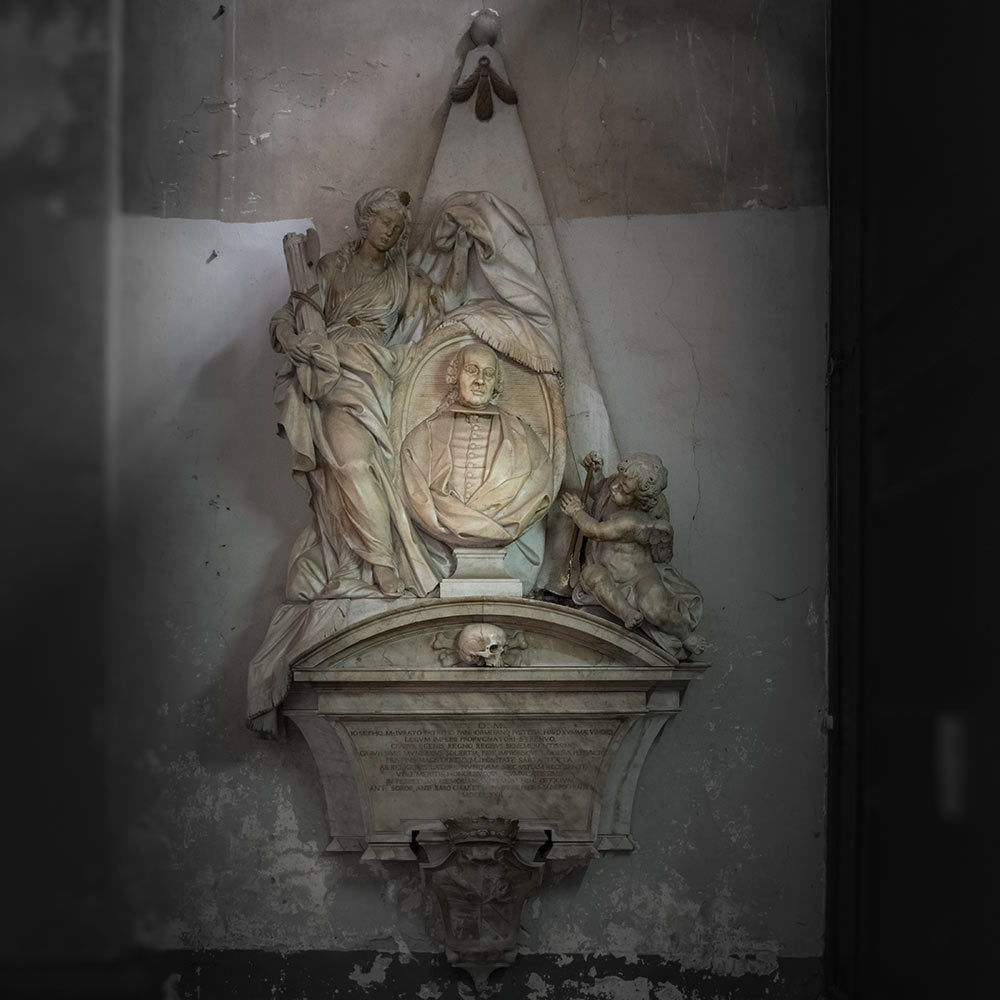
Tomb (1772) in Chiesa di S. Ninfa dei Crociferi, Palermo (Sicilia).
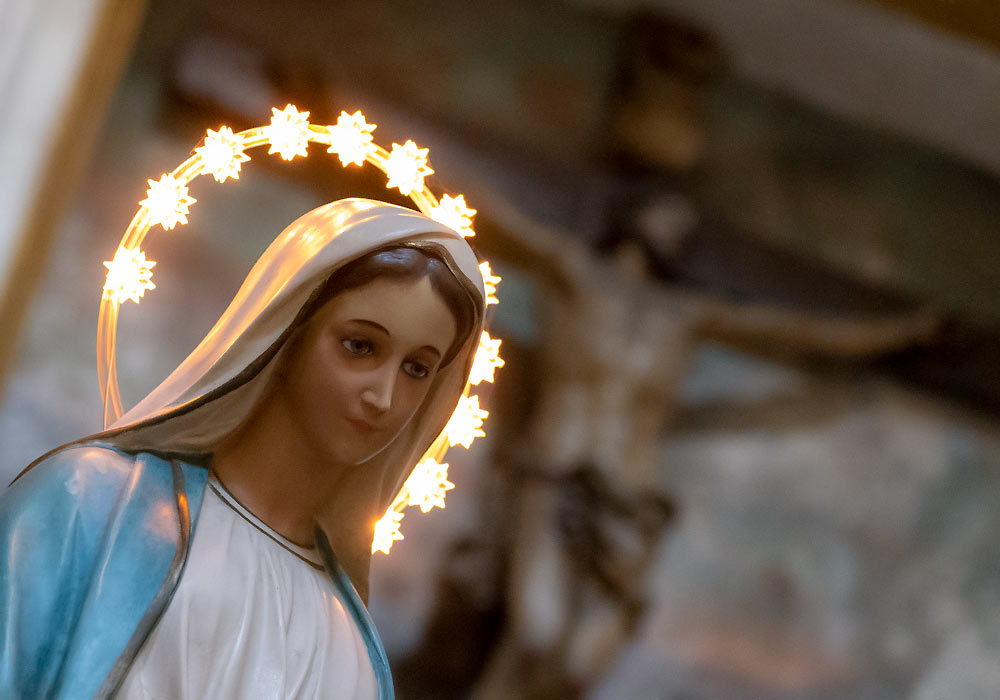
Mary in front of a crucifix. Chiesa di S. Ninfa dei Crociferi, Palermo. ”Dei Crociferi” is indicating a connection to the Crucified Christ, possibly highlighting the church's association with the Passion of Christ or the religious order that managed it.
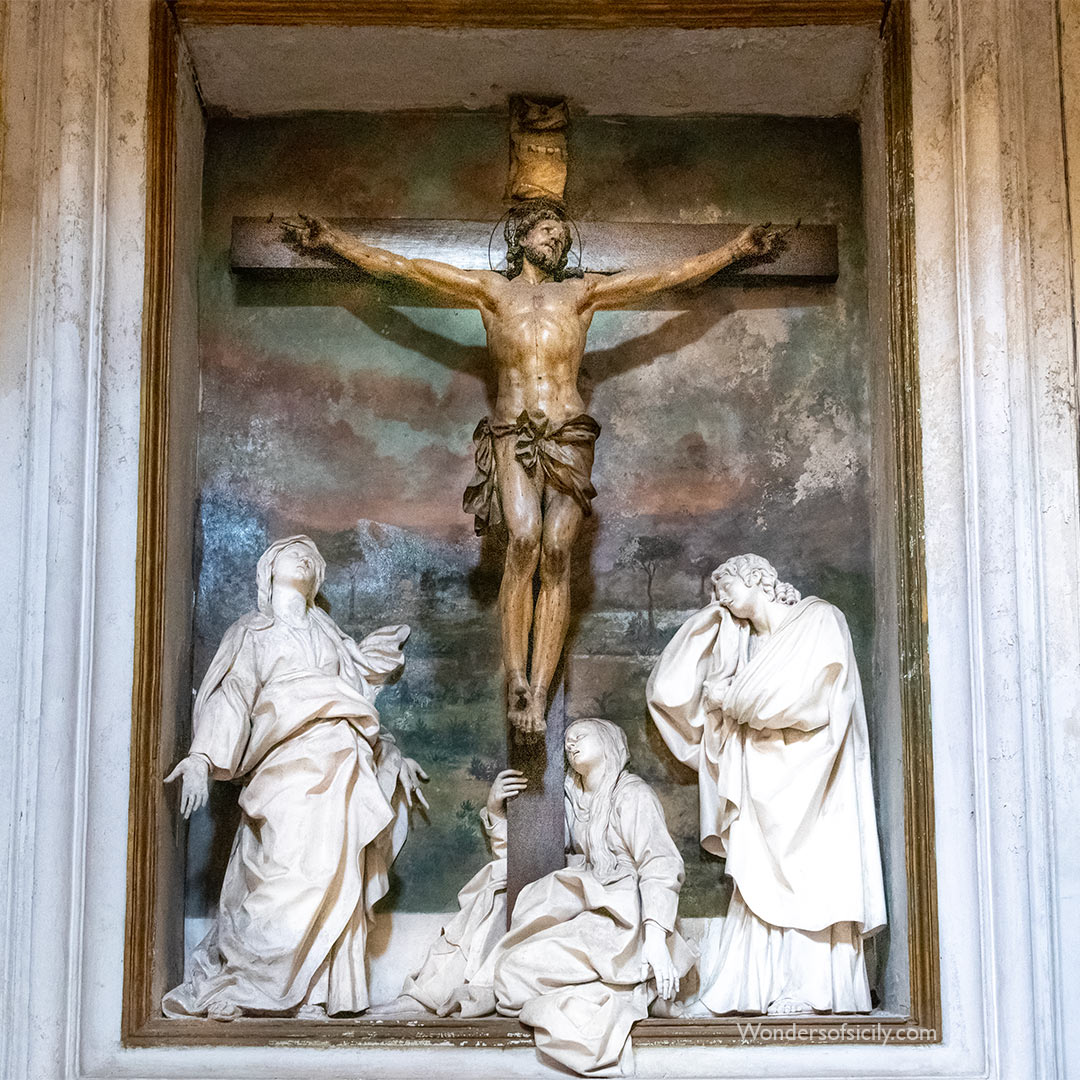
Calvary group made in stucco by Giacomo Serpotta in Chiesa di S. Ninfa dei Crociferi (Palermo). The Virgin, Saint John the Apostle, and Saint Mary Magdalene. A fresco landscape is seen in the background. The Crucifix Chapel contains the Marassi family’s crypt.
Chiesa del Carmine Maggiore
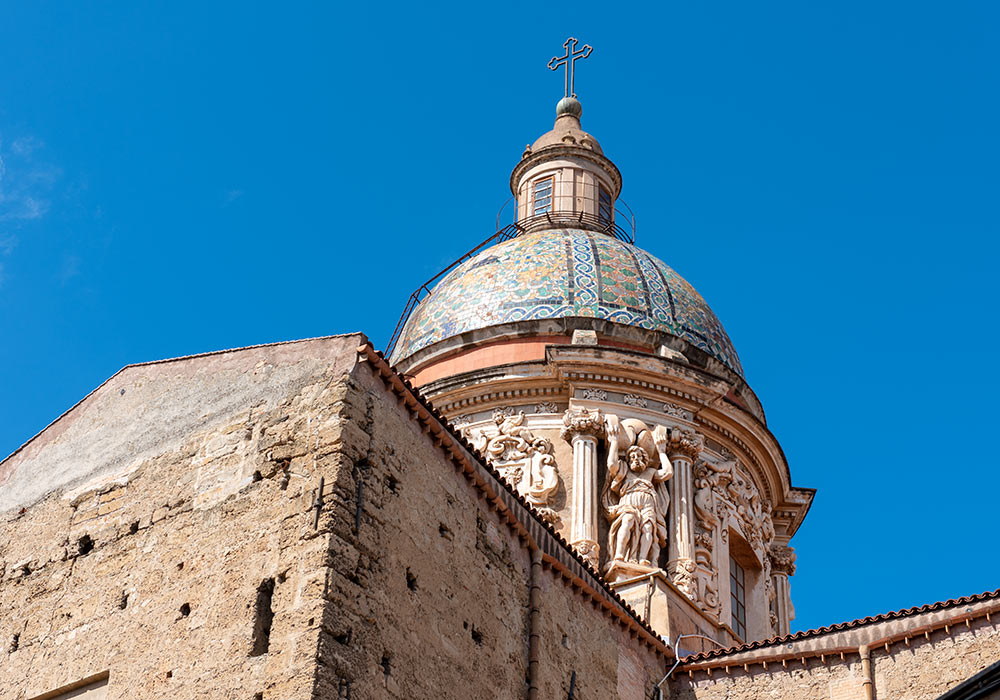
Chiesa del Carmine Maggiore with its spectacular dome.
Chiesa dell'Immacolata Concezione (Church of the Immaculate Conception)
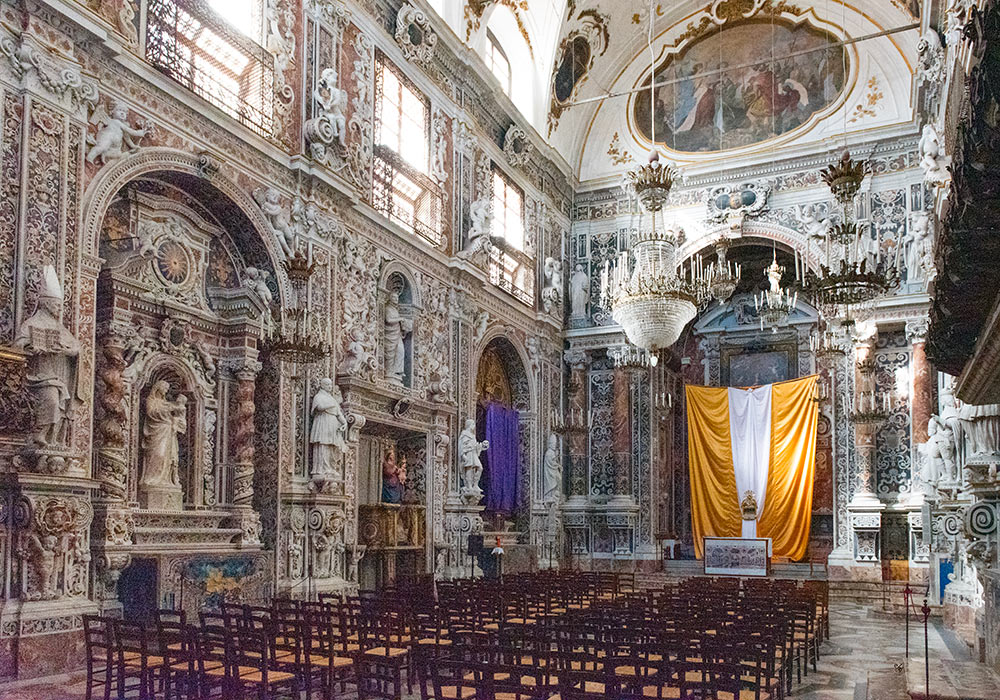
The remarkable Church of the Immaculate Conception (Immaculata al Capo) offers the finest display of exquisite marbling in Palermo, rivaled only by the more famous Casa Professa (Chiesa del Gesù). Unlike Casa Professa, however, the Church of the Immaculate Conception was spared the heavy bombing by British and American forces during World War II, preserving its stunning artistry.
Chiesa di Santa Caterina d'Alessandria
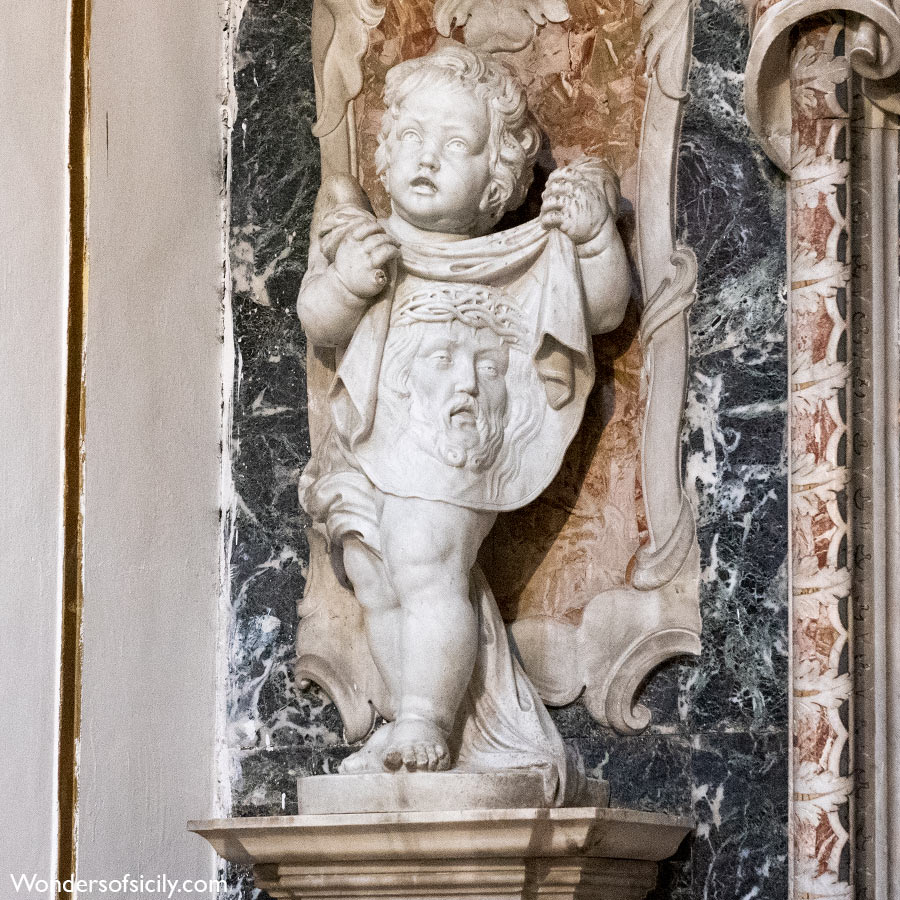
Putto with Veronica's veil. Chiesa di Santa Caterina d'Alessandria, Palermo.
Monreale
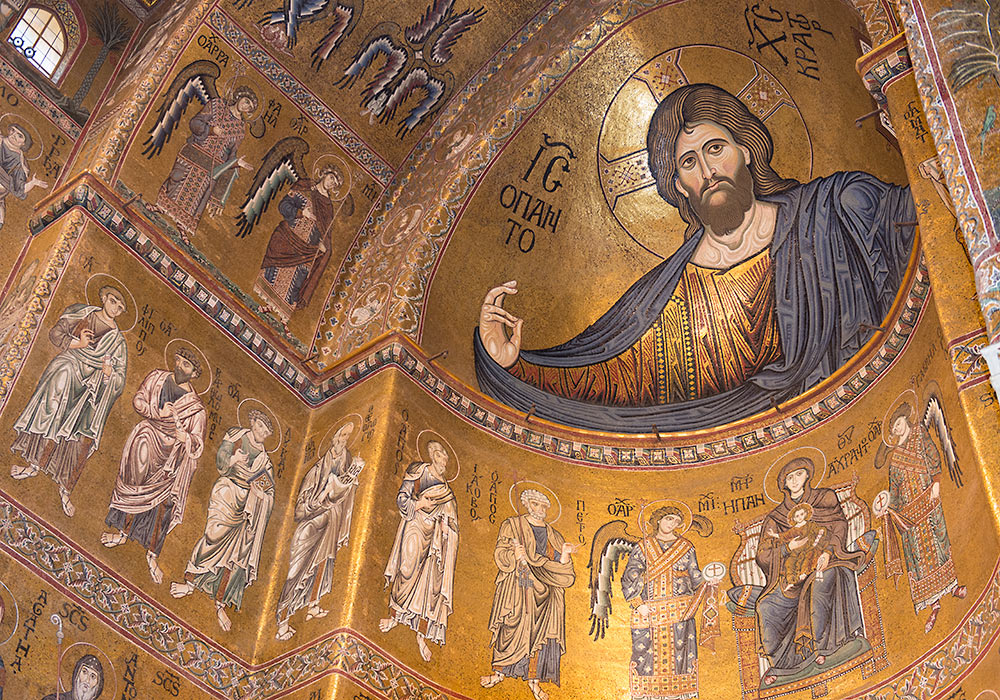
Photo: Per-Erik Skramstad / Wonders of Sicily
Christ Pantocrator: The cathedral in Monreale, Palermo, is regarded as the most beautiful of the Norman churches in Sicily. The mosaics were made with 2200 kg of pure gold, experts have estimated. Craftsmen from Constantinople were employed to expedite the work. The Byzantine mosaics are among the most magnificent in the world.
The most common translation of Pantocrator is "Almighty" or "All-powerful". In this understanding, Pantokrator is a compound word formed from the Greek words πᾶν, pan (gen. pantos), i.e. "all" and κράτος, kratos, i.e. "strength", "might", "power". This is often understood in terms of potential power; i.e., ability to do anything, omnipotence. Another, more literal translation is "Ruler of All" or, less literally, "Sustainer of the World". In this understanding, Pantokrator is a compound word formed from the Greek for "all" and the verb meaning "To accomplish something" or "to sustain something" (κρατεω). This translation speaks more to God's actual power; i.e., God does everything (as opposed to God can do everything).
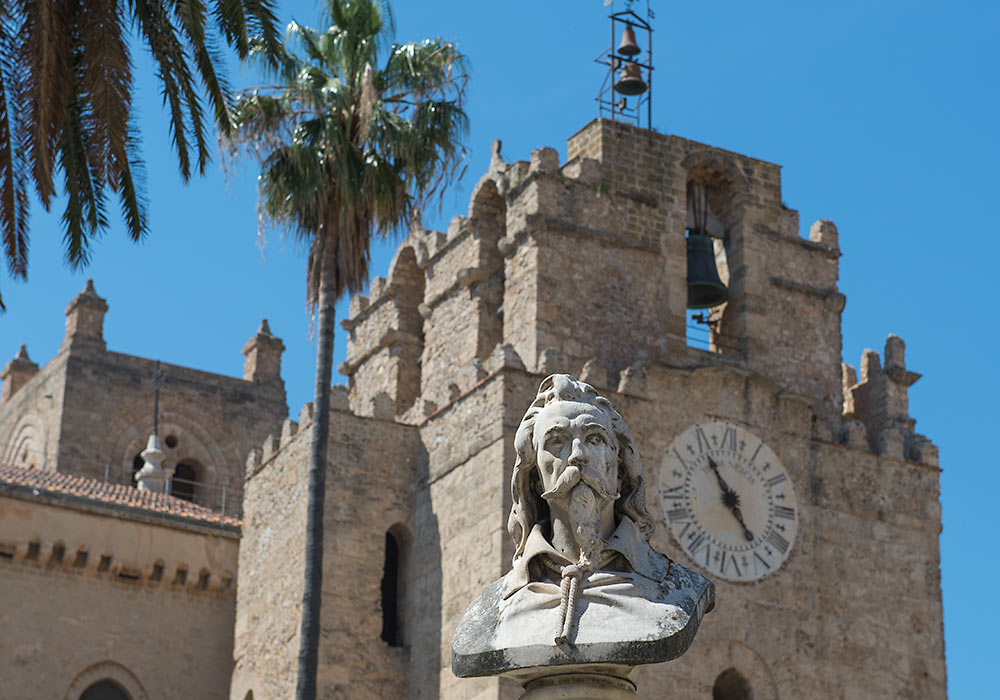
Bust of the painter Pietro Novelli in front of the bell tower of the cathedral in Monreale, Palermo.
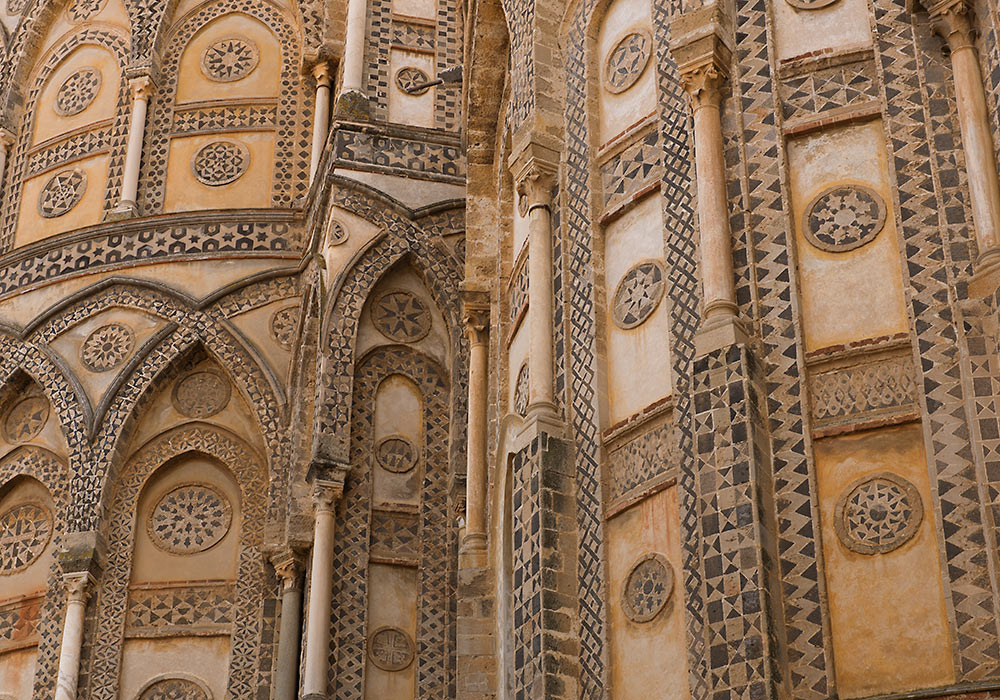
"Monreale" is a contraction of monte-reale, "royal mountain". According to Lisa Sciortino (The Cathedral of Monreale), the rear part of the cathedral "preserves intact its Norman imprint and is decorated with design elements comprising a series of black and white stone arches with neatly orderes circles beneath. The apses, with their dense interweaving ogival arches evoke Moorish atmospheres accentuated by a polychrome decoration."
The inlaid lava stones are from Vesuvius.
The outsides of the principal doorways and their pointed arches are magnificently enriched with carving and colored inlay, a curious combination of three styles - Norman-French, Byzantine and Arab.
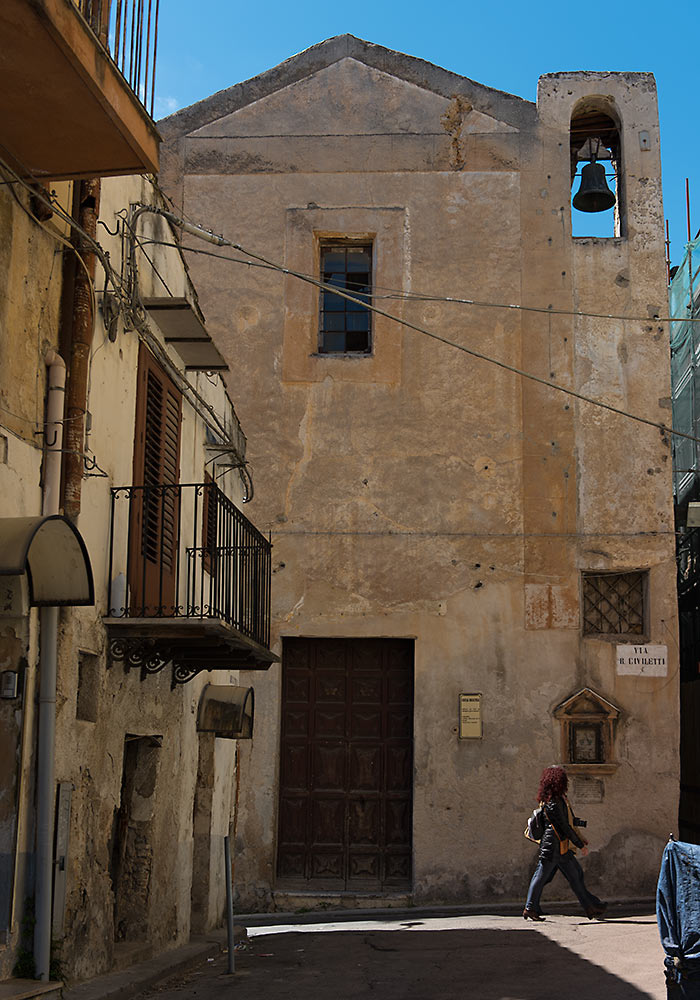
Chiesa Odigitria (Via B Civiletti) in Monreale was built by Greek-Albanian immigrants in 1596. The church has a frescoed ceiling by Pietro Novelli and stuccoes by Giacomo Serpotta. The church has been closed all the times I have visited Monreale.
Termini Imerese
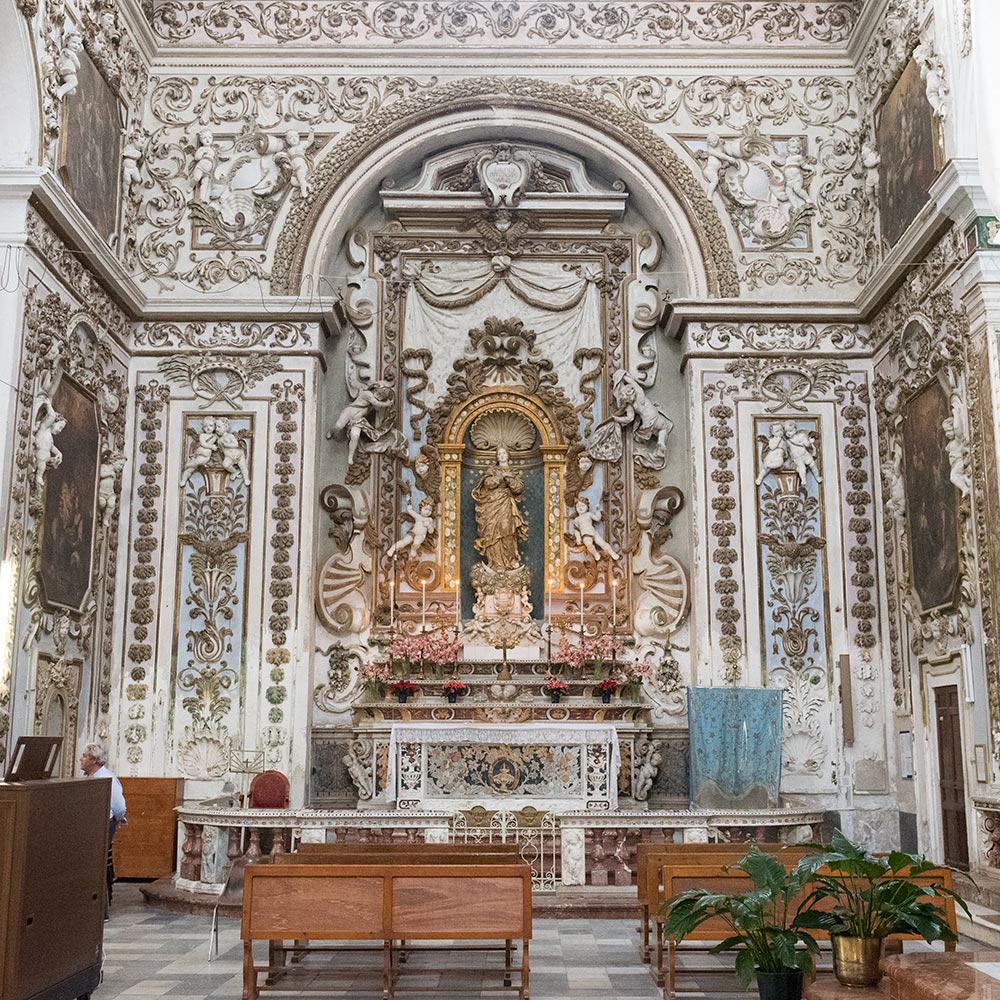
The High Altar of the Termini Imerese Cathedral.
Noto
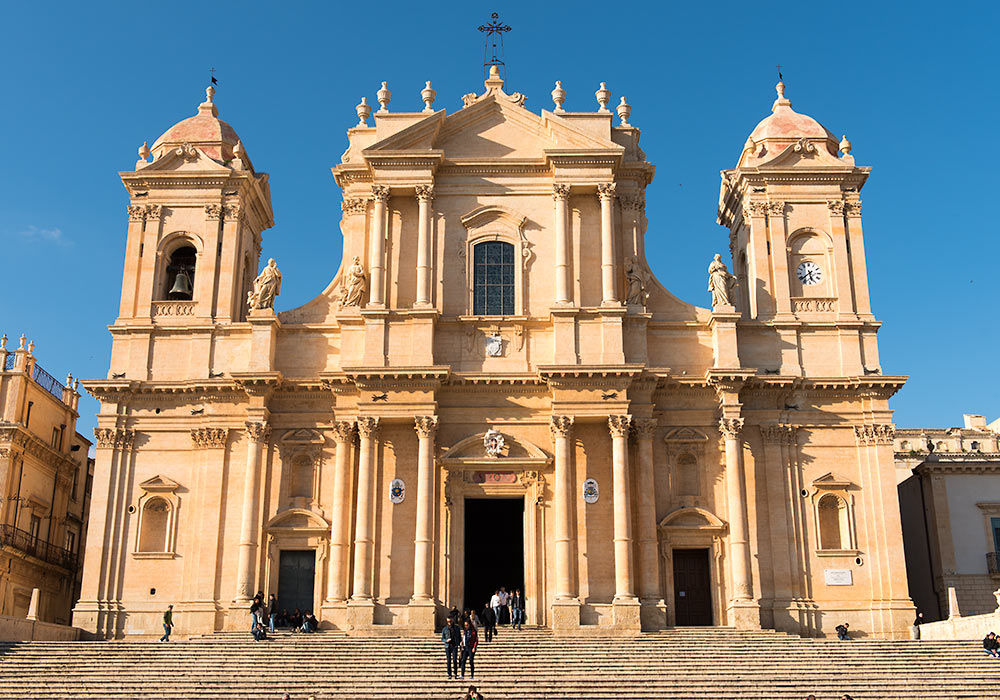
The baroque cathedral in Noto.
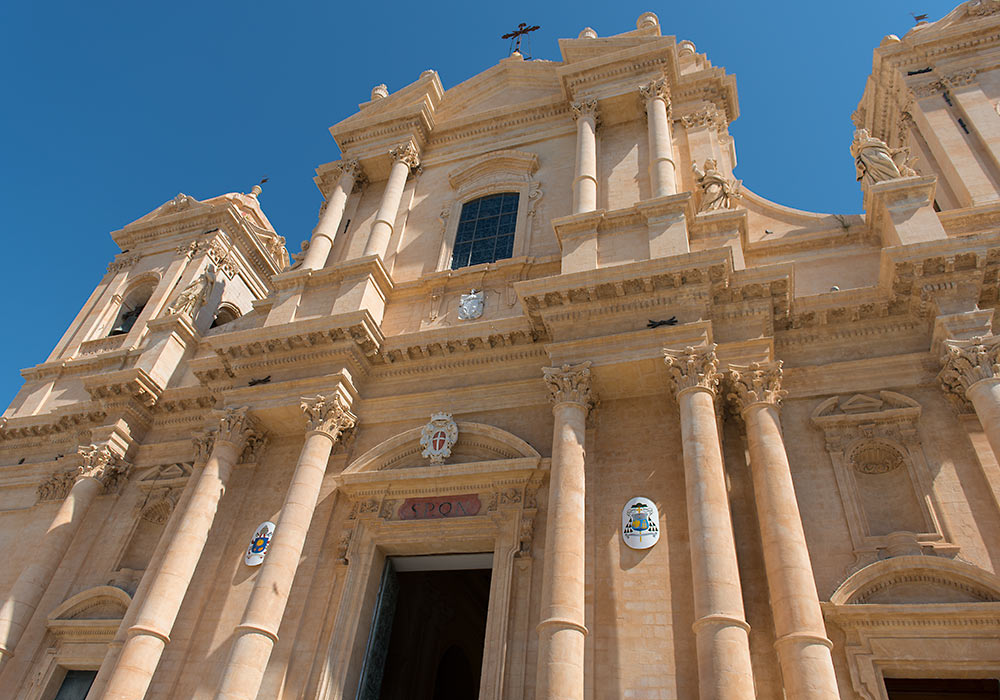
The baroque cathedral in Noto seen from a low angle.
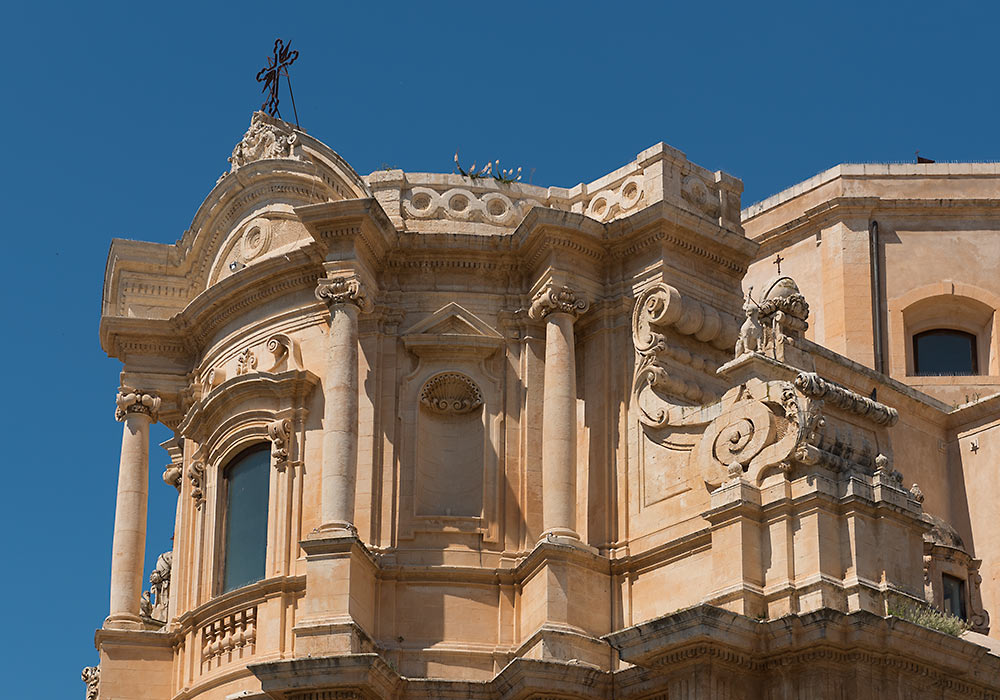
Noto: Detail of the church of San Domenico by Rosario Gagliardi from Syracuse.
The cathedral of San Nicola di Bari in Nicosia, Sicily
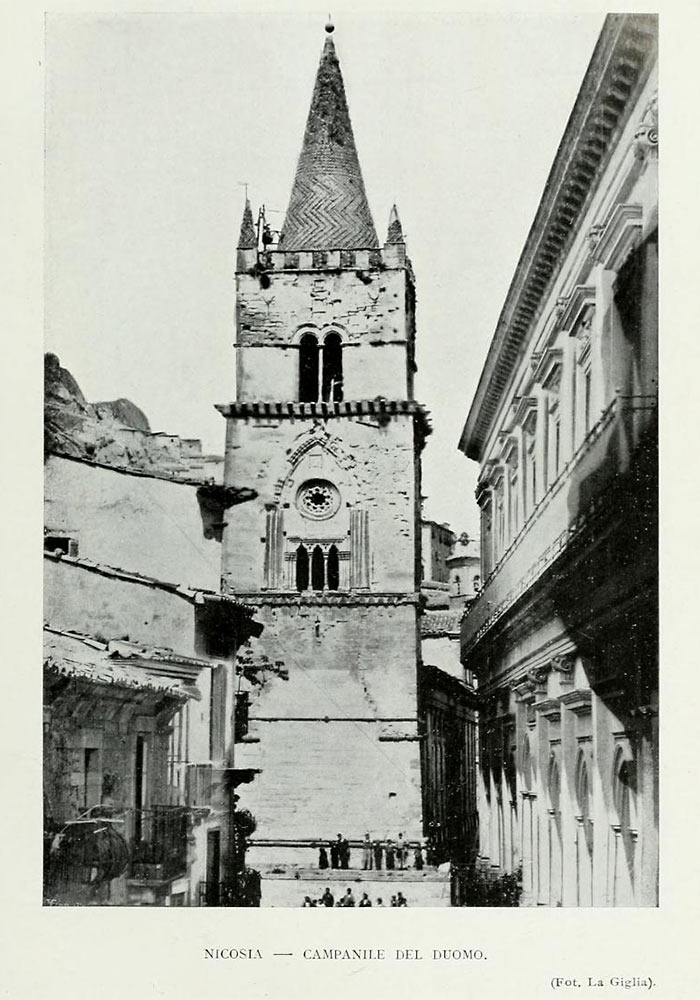
The belfry of the cathedral (duomo) in Nicosia anno c. 1907.
The cathedral of San Nicola di Bari in Nicosia, Sicily
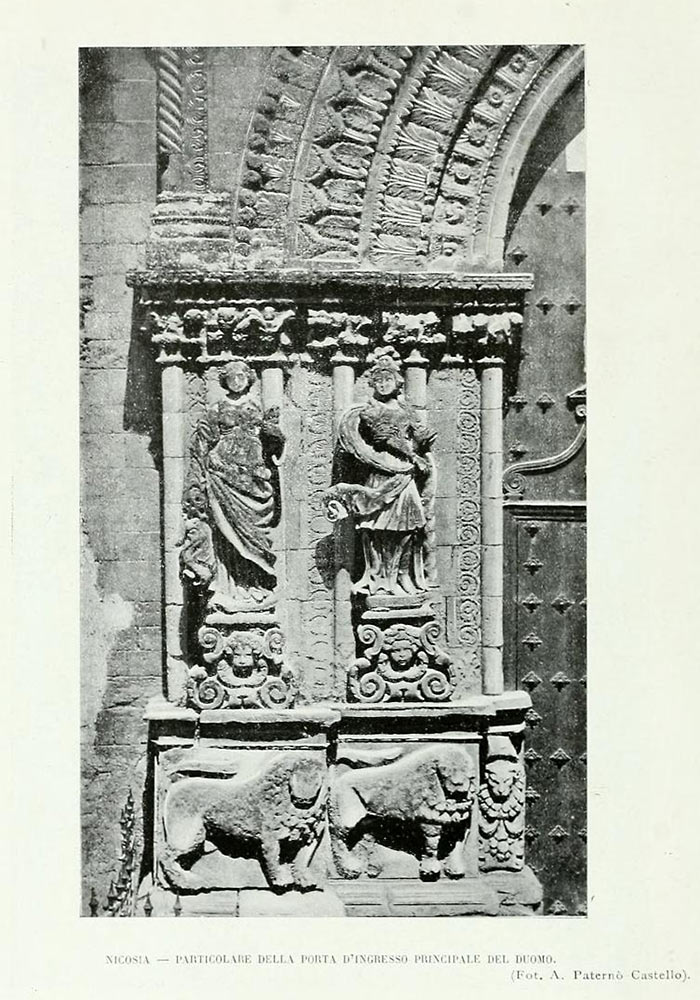
Detail of the portal of the cathedral in Nicosia anno c. 1907.
Sicilian Sites on UNESCO's World Heritage List
- Agrigento: Archaeological Area of Agrigento (UNESCO)
- Aeolian Islands: Isole Eolie. The group consists of seven islands (Lipari, Vulcano, Salina, Stromboli, Filicudi, Alicudi and Panarea) and five small islets (Basiluzzo, Dattilo, Lisca Nera, Bottaro and Lisca Bianca) in the vicinity of Panarea. (UNESCO)
- Caltagirone (UNESCO)
- Catania (UNESCO)
- Cefalù Cathedral
- Militello Val di Catania (UNESCO)
- Modica (UNESCO)
- Monreale Cathedral
- Mount Etna (UNESCO)
- Noto (UNESCO)
- Palermo: Palazzo dei Normanni (The Norman Palace)
- Palermo: Cappella Palatina (The Palatine Chapel in the Norman Palace)
- Palermo: Church of San Giovanni degli Eremiti
- Palermo: Church of Santa Maria dell'Ammiraglio (also known as the Martorana)
- Palermo: Church of San Cataldo
- Palermo: Cathedral of Palermo
- Palermo: The Zisa Palace (La Zisa)
- Palermo: The Cuba Palace (La Cuba)
- Palazzolo Acreide (UNESCO)
- Ragusa (UNESCO)
- Scicli (UNESCO)
- Syracuse and the Rocky Necropolis of Pantalica (UNESCO)
Cefalù
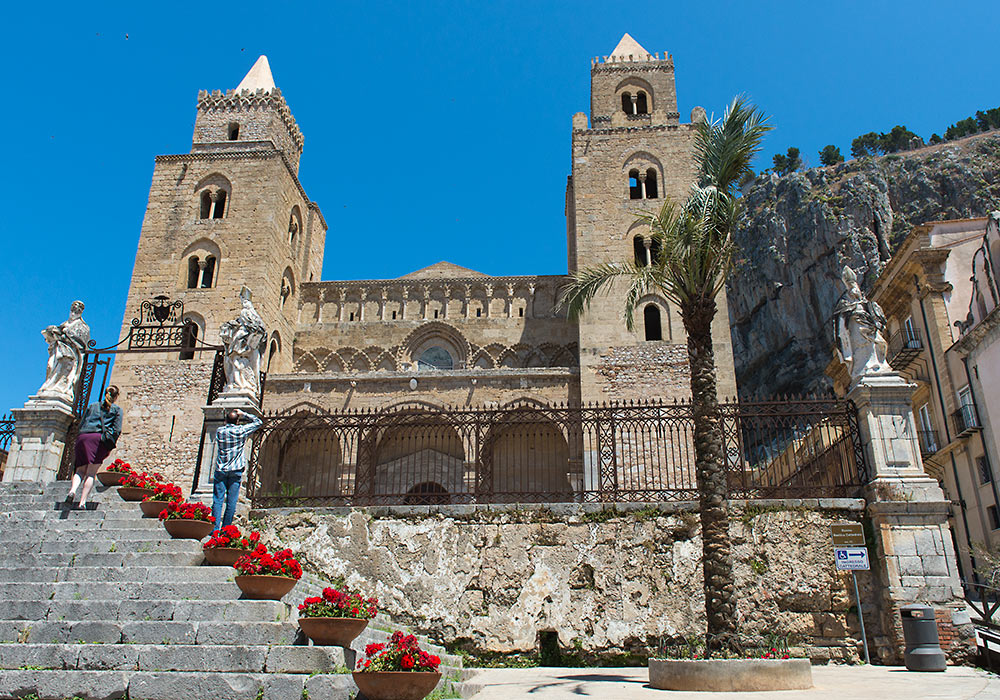
Photo: Per-Erik Skramstad / Wonders of Sicily
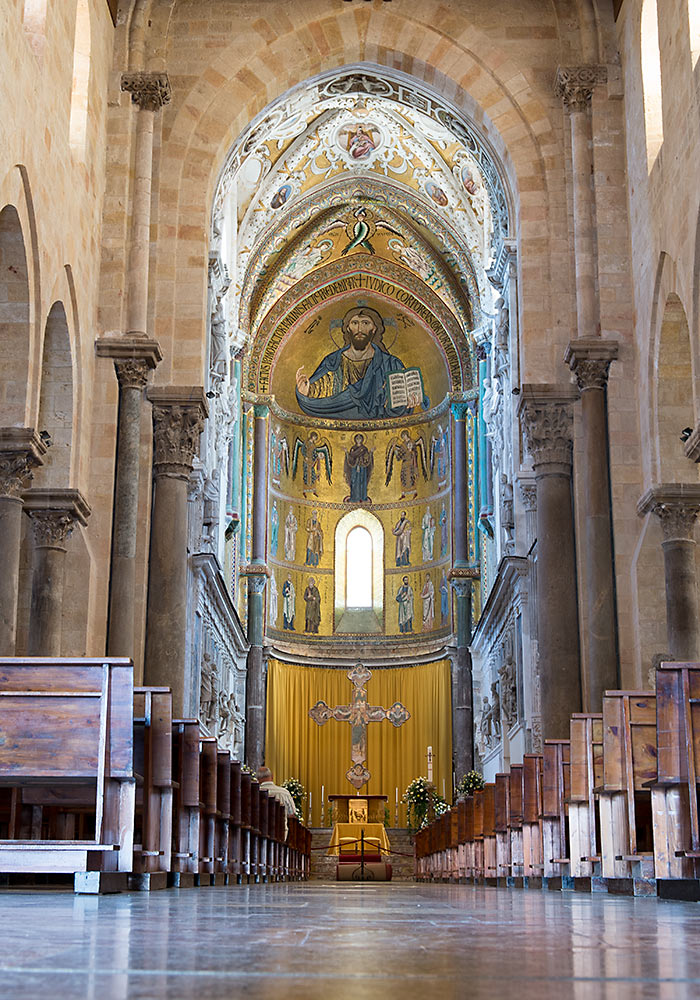
According to the historian John Julius Norwich (author of "The Normans in Sicily") the representation of the Pantocrator is the most sublime of all – "perhaps of Christ in any form in all Christian art". Construction began in 1131, the apse mosaics begun in 1145. After 1172 the church suffered a period of decline; the façade was completed in 1240. The Cathedral was consecrated in 1267 by Rodolphe de Chevriêres, Bishop of Albano.
Photo: Per-Erik Skramstad / Wonders of Sicily
Church of the Purgatorio (Chiesa di Santo Stefano Protomartire)
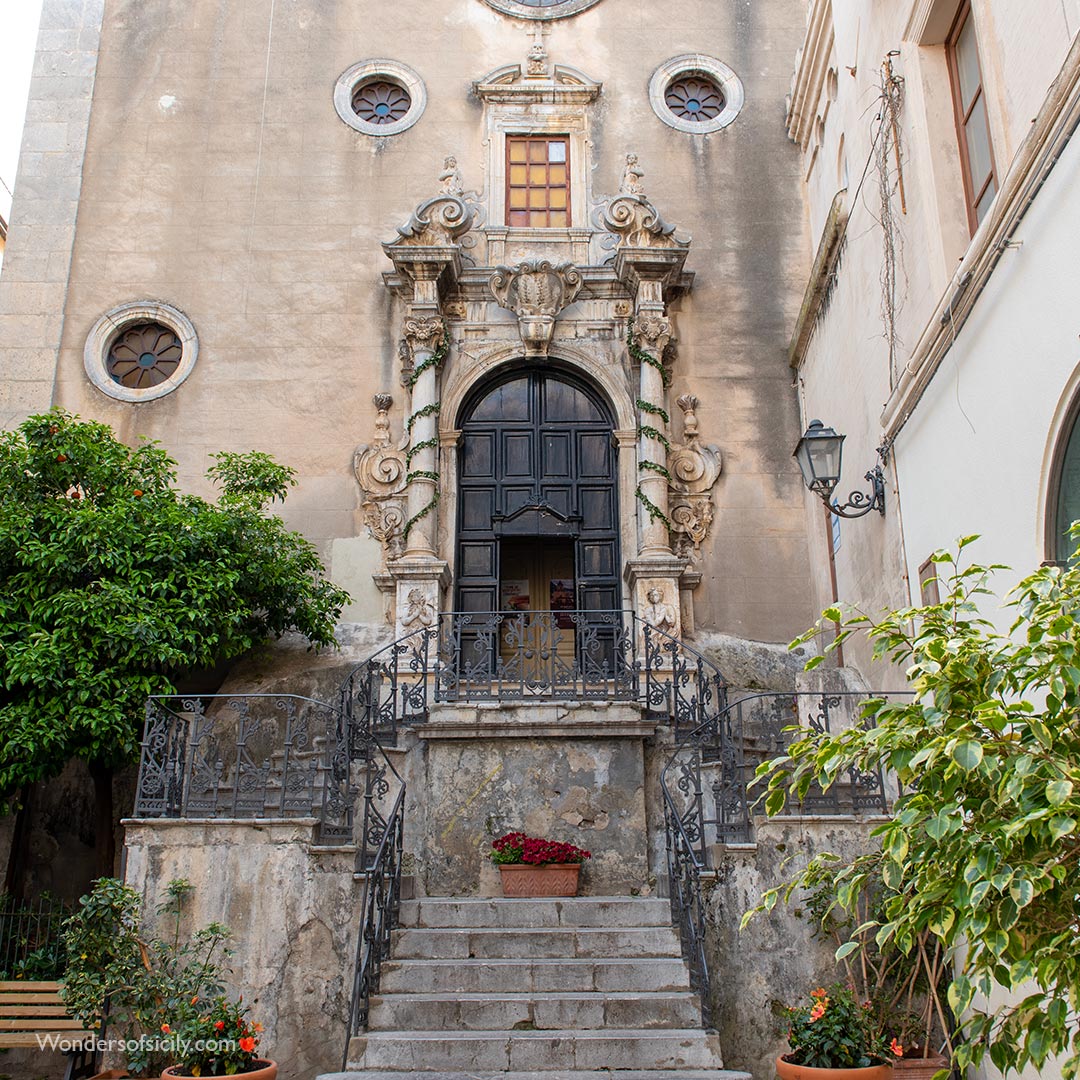
The Church of the Purgatorio (Chiesa di Santo Stefano Protomartire) between Corso Ruggero 104 and 106, Cefalù. The church was built in the 15th century, restored 17th century. Notice the skulls above the entrance, for details see the page Death in Sicily.
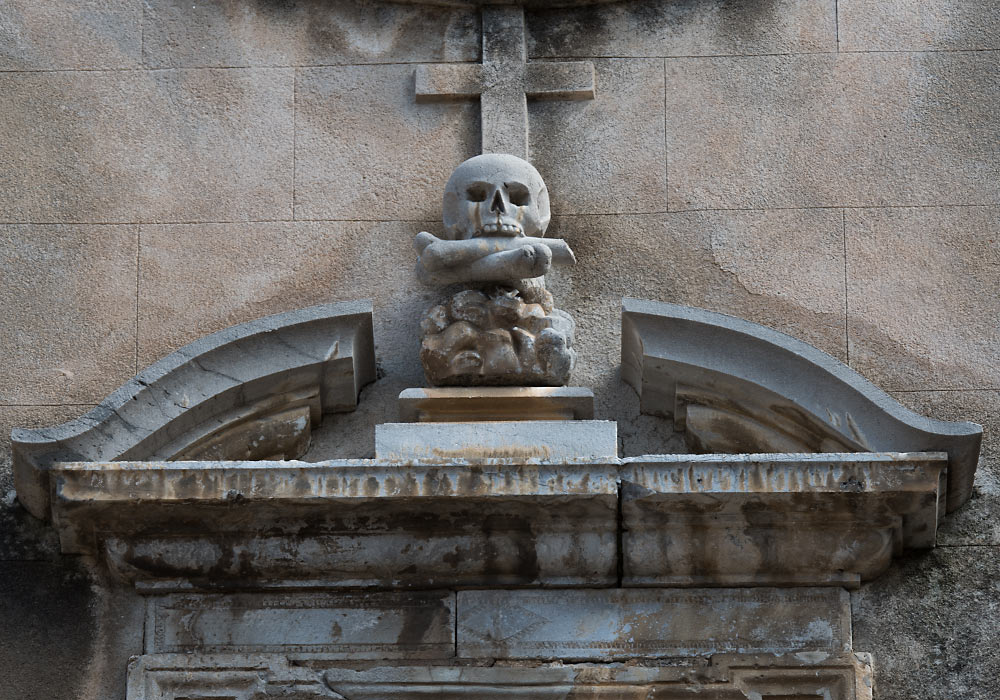
Detail of the exterior of the Church of the Purgatorio (Santo Stefano Protomartire) in Cefalù.
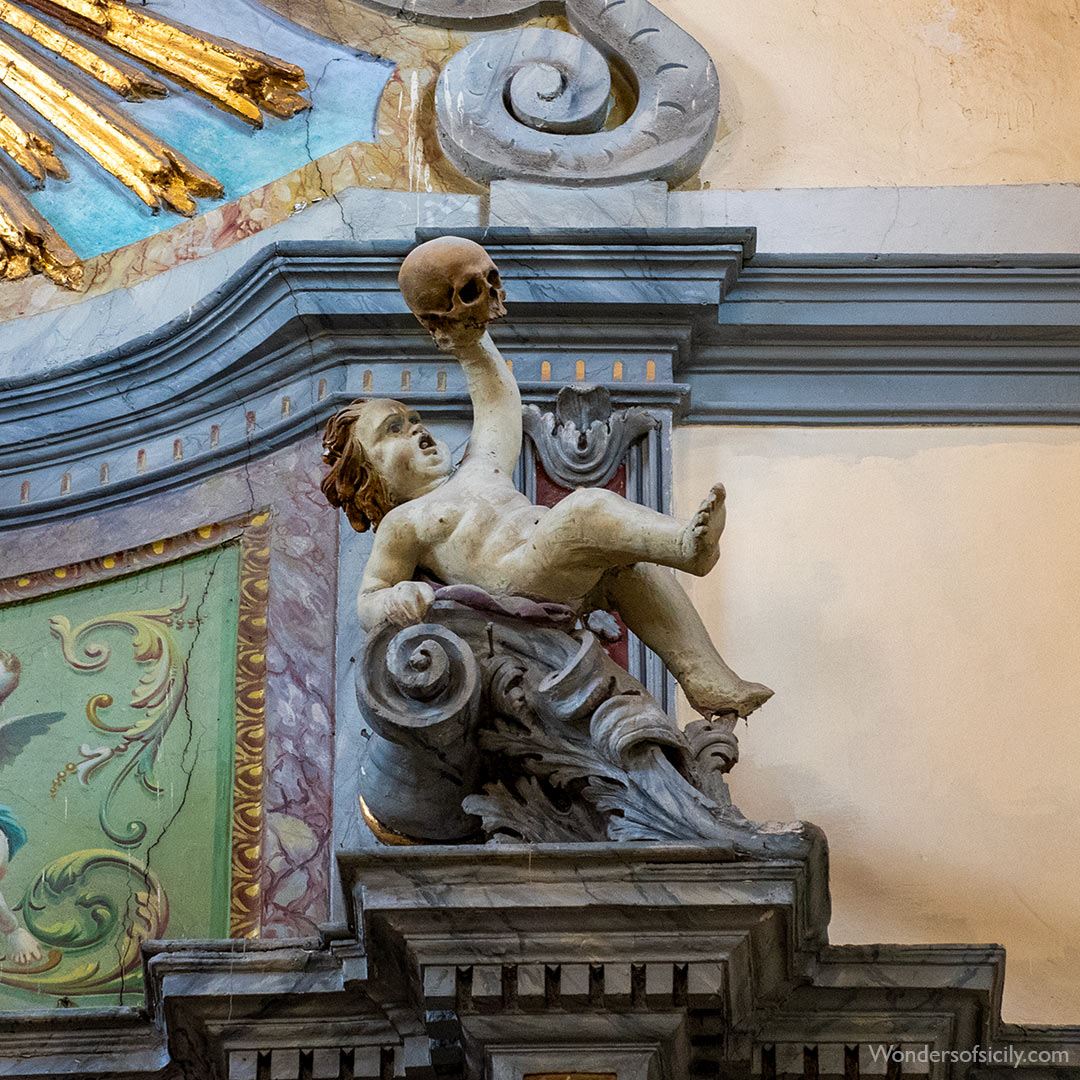
Putto holding a skull. Church of the Purgatorio (Santo Stefano).
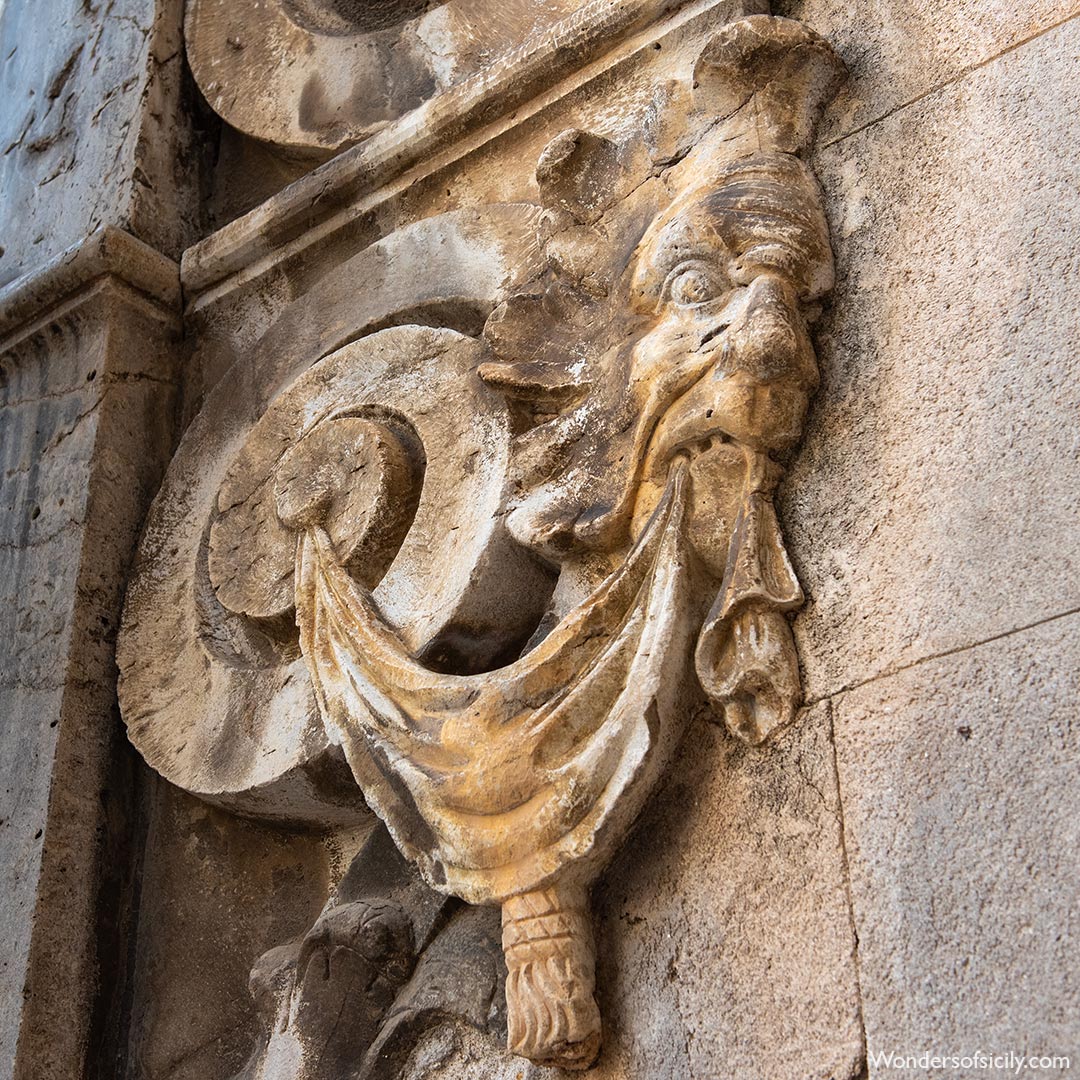
Relief by the main entrance of Chiesa di Santo Stefano.
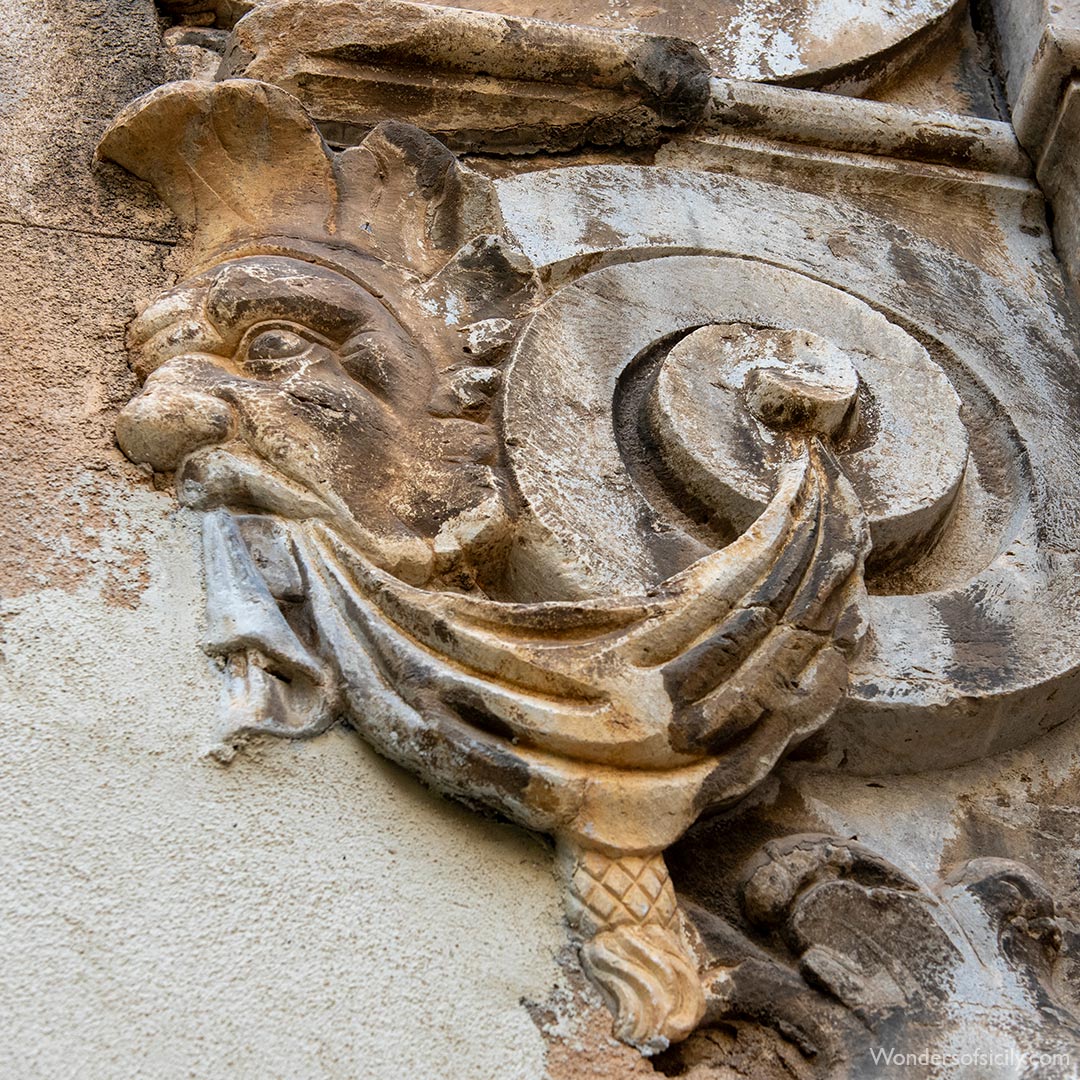
Relief by the main entrance of Chiesa di Santo Stefano, Cefalù.
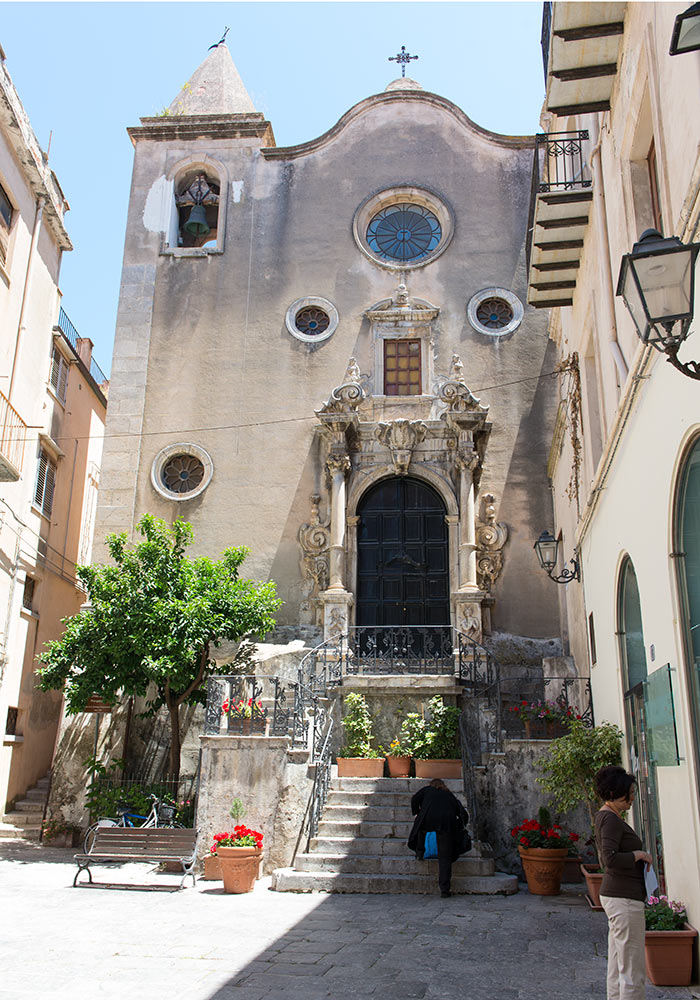
The Church of the Purgatorio (Chiesa di Santo Stefano Protomartire).
Chiesa di Santa Maria
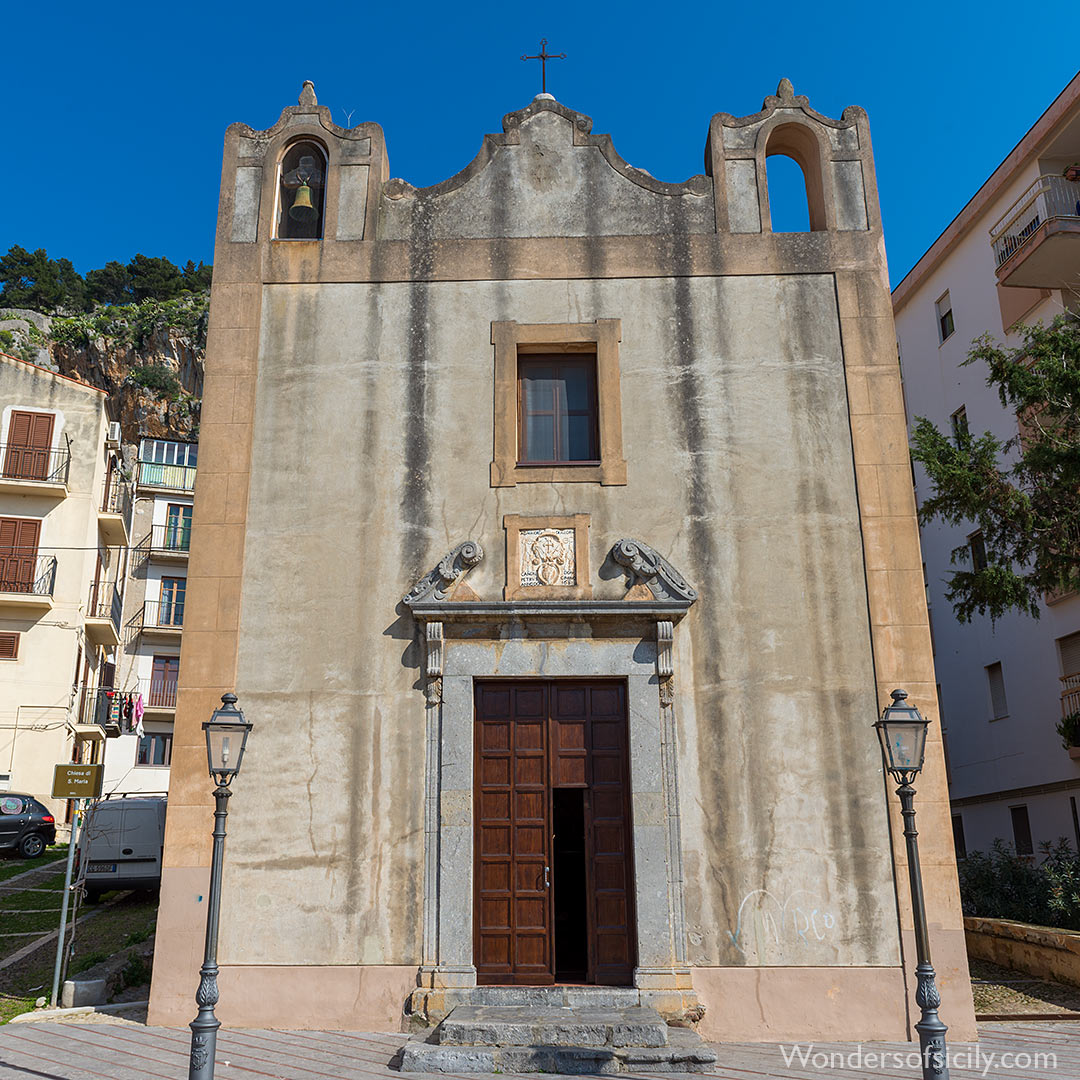
Chiesa di Santa Maria (15 Via Umberto I)
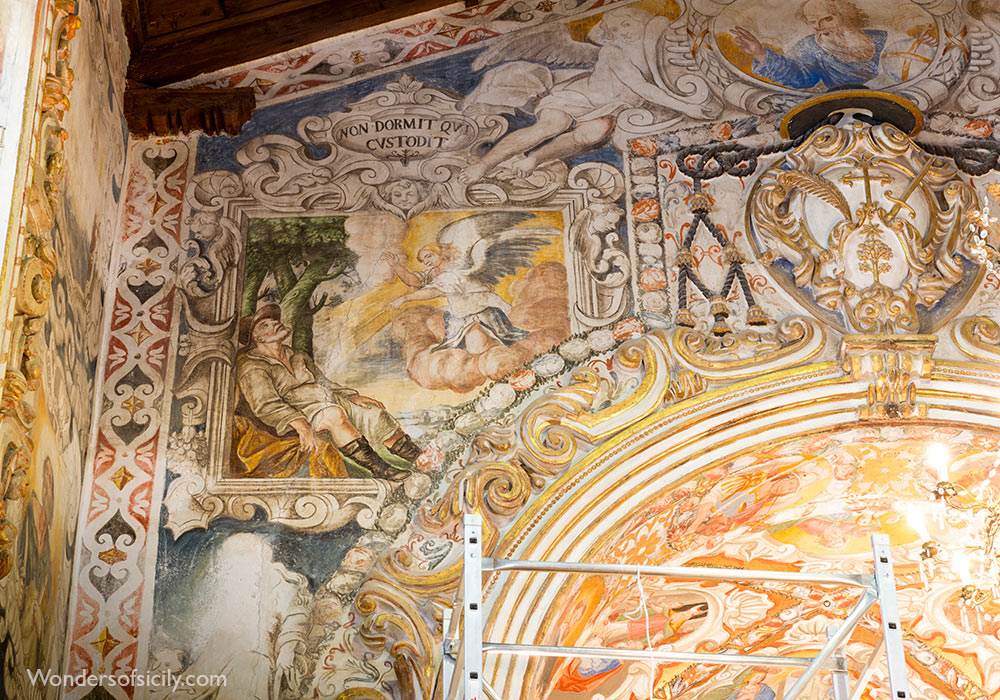
The Baroque murals of the Church of Santa Maria were being restored when I visited the church March 2015.
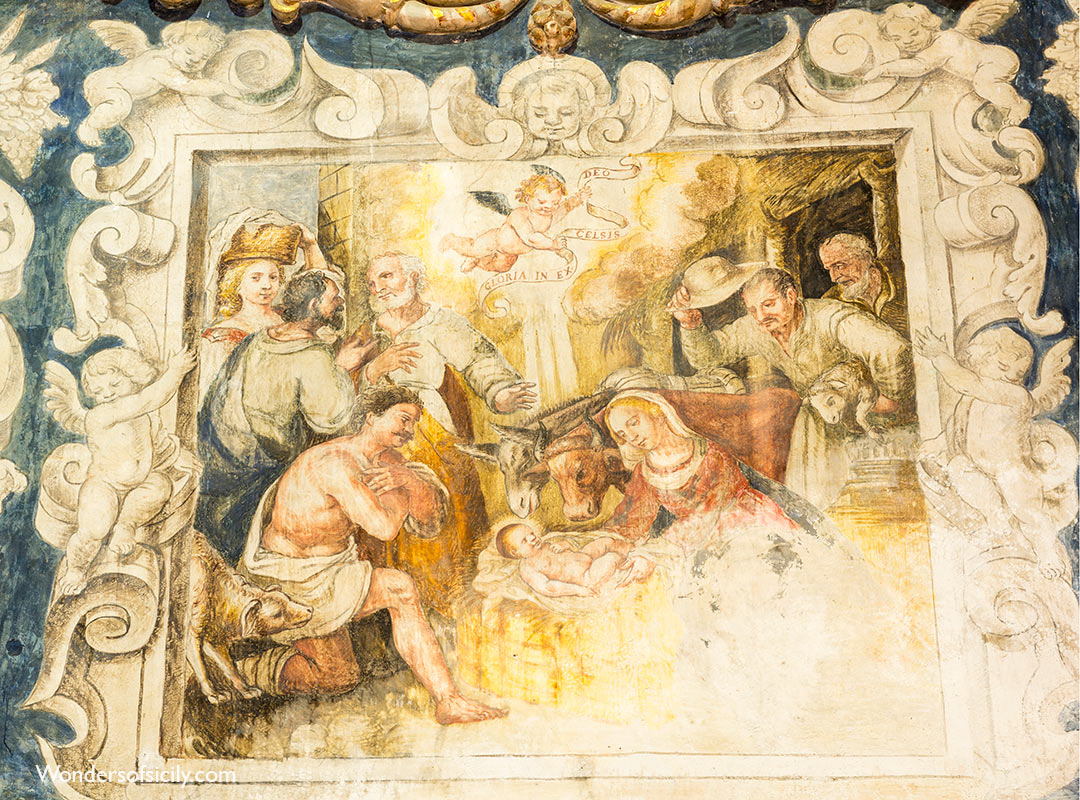
Baroque mural in the Chiesa di S. Maria, Cefalù.
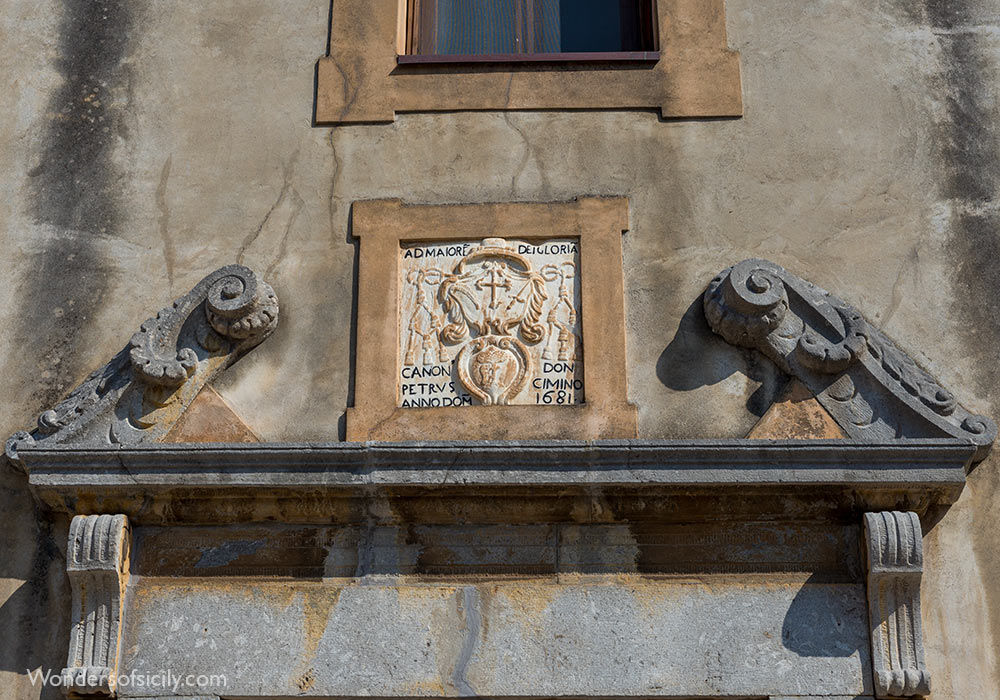
Entrance of Chiesa di Santa Maria. Anno 1681.
Chiesa di San Leonardo
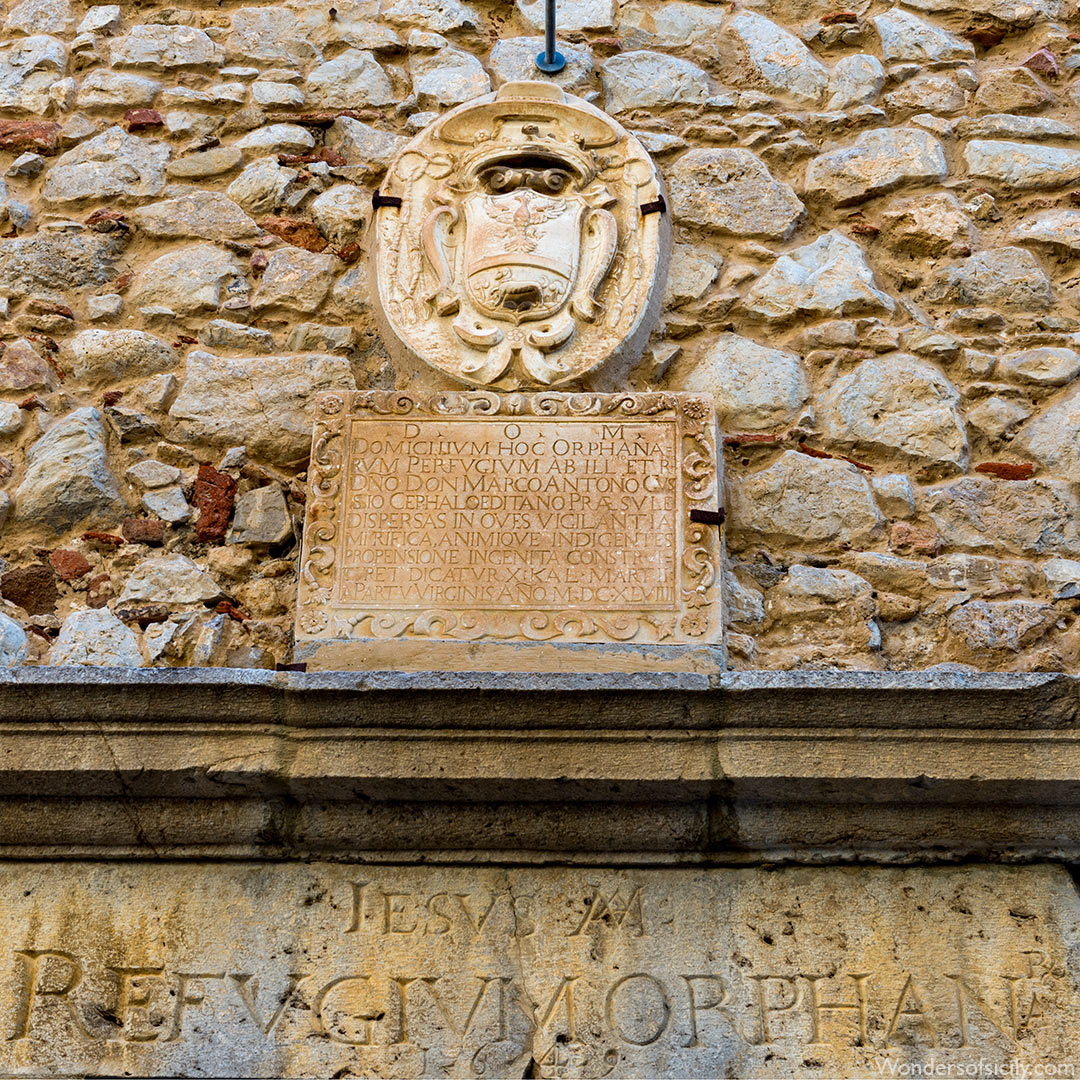
The church of San Leonardo was originally dedicated to San Giorgio. According to a Wikipedia article about the church (which has no references), it is mentioned in documents of 1159 and 1252 and is attributed to a foundation by Roger II prior to that of the cathedral. It was restored in 1558, a period in which it seems to have received its current title. In 1648 it was annexed to the "House of sheltered orphan girls" by bishop Marco Antonio Gussio, and in 1875 it was restored again by bishop Ruggero Blundo. There remain traces of the original central portal, currently closed off. (The information is not verified.)
Halaesa Arconidea (aka Alesa Arconidea)
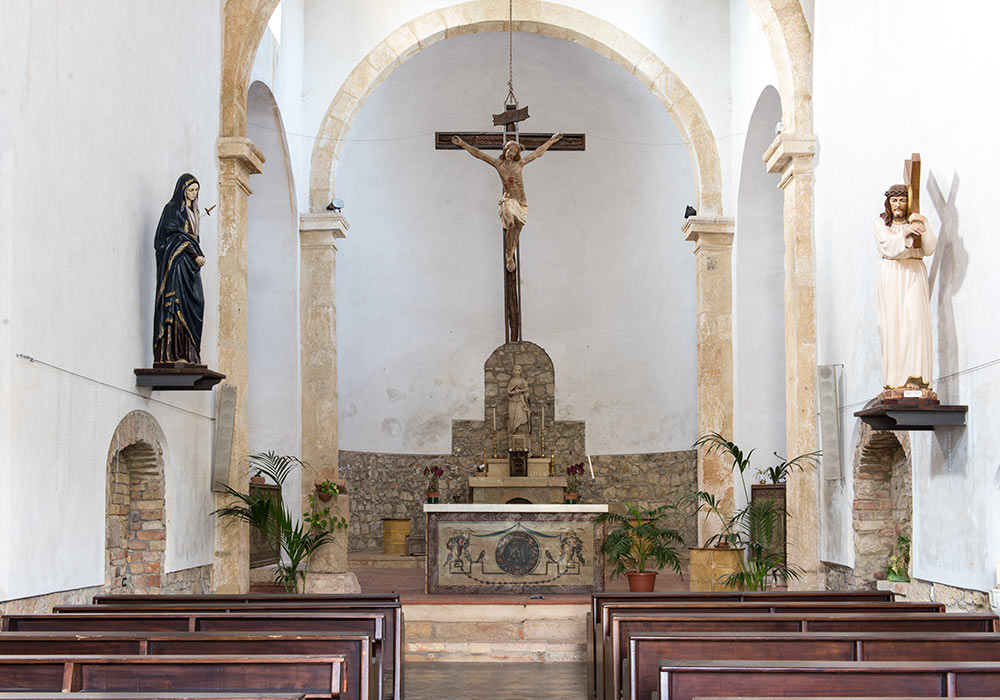
Next to the custodian's house at Halaesa Arconidea (aka Alesa Arconidea) lies a medieval church, Santa Maria delle Palate, with some original painted statues in wood and a Madonna and Christ holding a globe in their hands made by the Gagini school. During the Norman period the church housed a Benedictine monastery and cloister that belonged to the resident abbot of the Church of Saint Bartholomew in Lipari. The church was first mentioned in legal documents in 1123, and was restored by Pasqualino Scaluni in 1551.
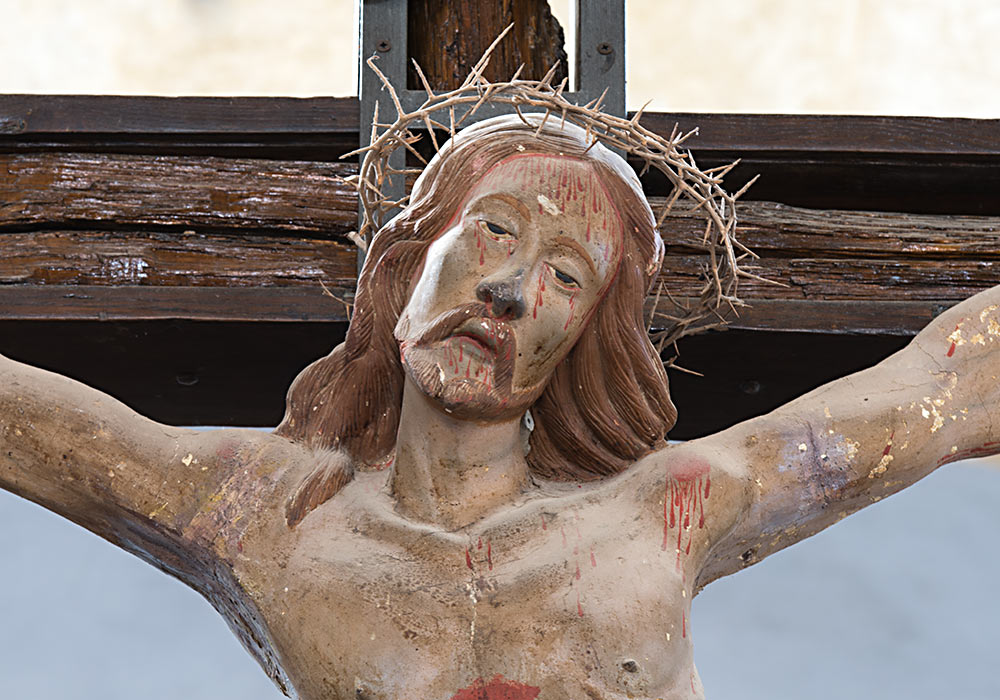
Detail of the crucified Christ in the medieval church Santa Maria delle Palate at Halaesa Arconidea.
Churches in Taormina
The Cathedral
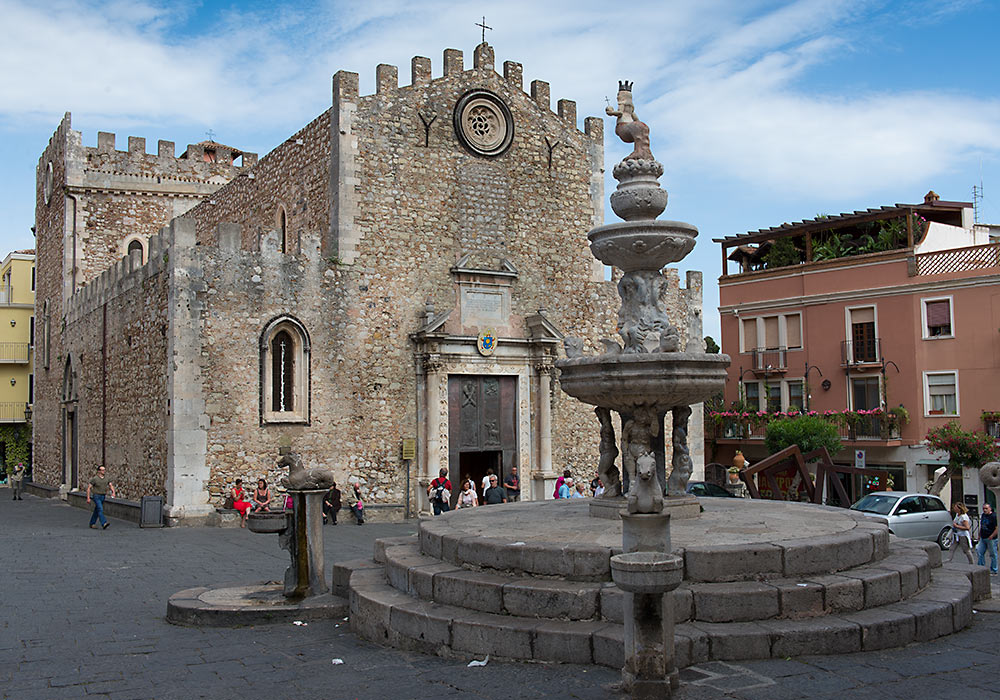
The cathedral, San Nicolò (a church dedicated to Saint Nicholas), built in the 13th century. Observe the crenelations on the roof. The portal was rebuilt in 1636. The fountain in front of the cathedral is baroque. The church occupies the area and the ruins of an earlier basilica. It was rebuilt in the 15th and 16th century and restored in the 18th century. Each doorjamb bears eleven carved figures showing some unidentified persons as well as Saint Peter with the keys of Paradise, saint Paul with the sword of Faith, king David with the cither, and the four evangelists: Saint Luke (the Bull), Saint John (the Eagle), Saint Matthew (the Angel), Saint Mark (the Lion). From 1945 to 1948, the church was fully restored by the Neapolitan architect Armando Dillon.
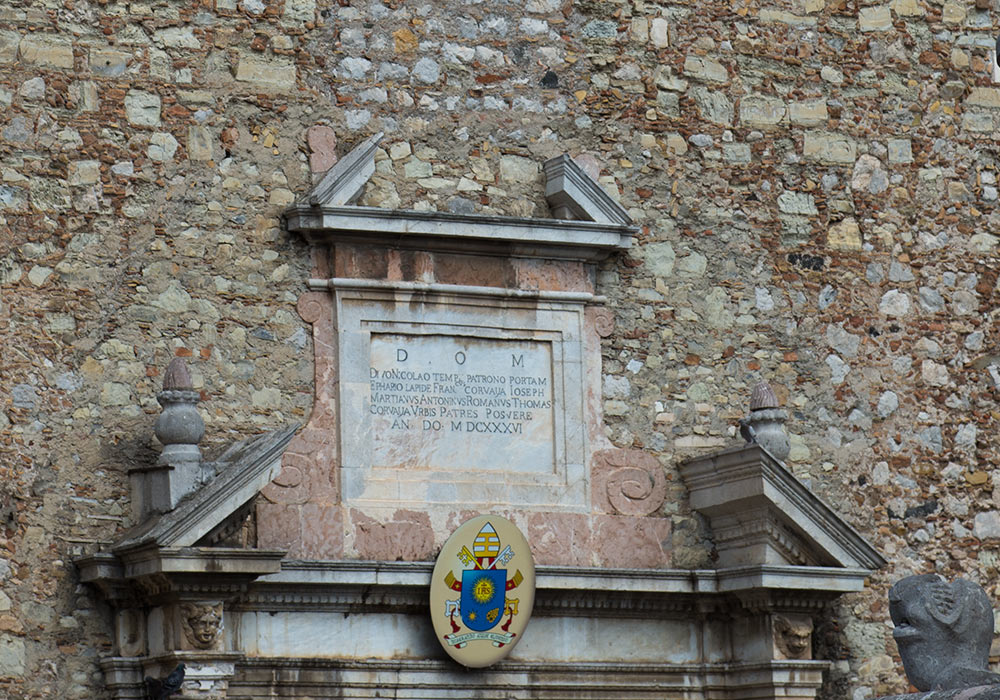
The top of the portal (1636 - MDCXXXVI) of the cathedral in Taormina with the inscription showing it was rebuilt in 1636.
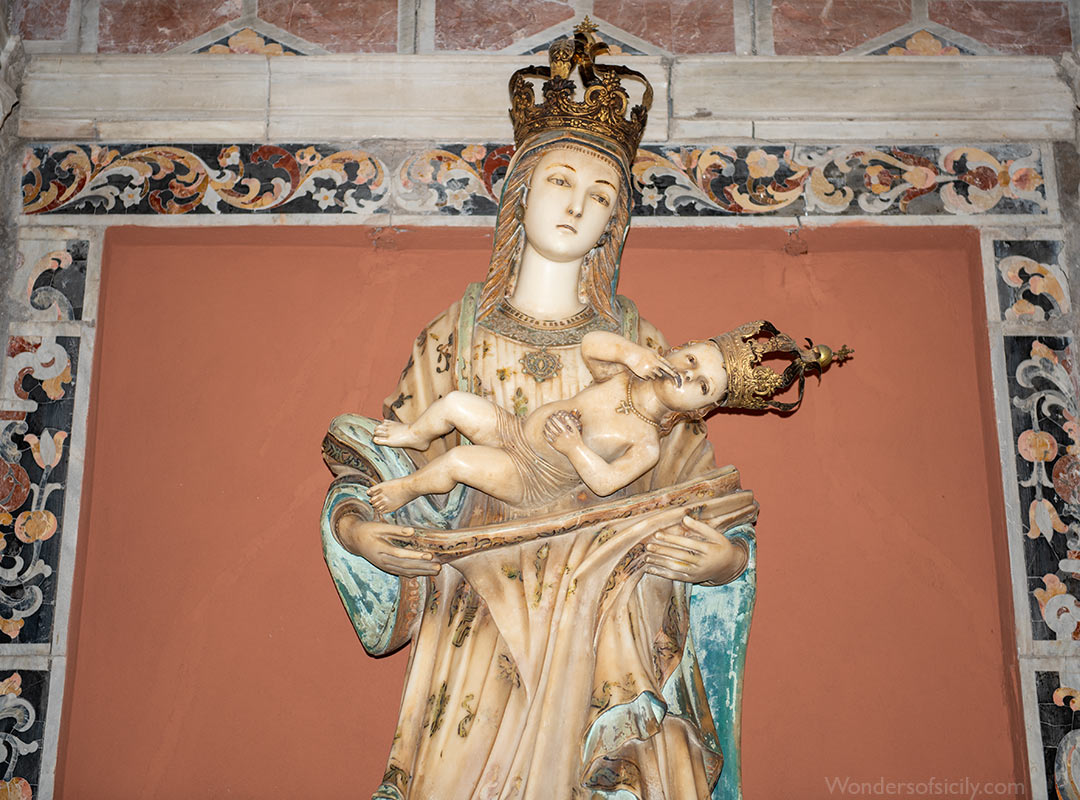
16th century statue of the Virgin and Child.
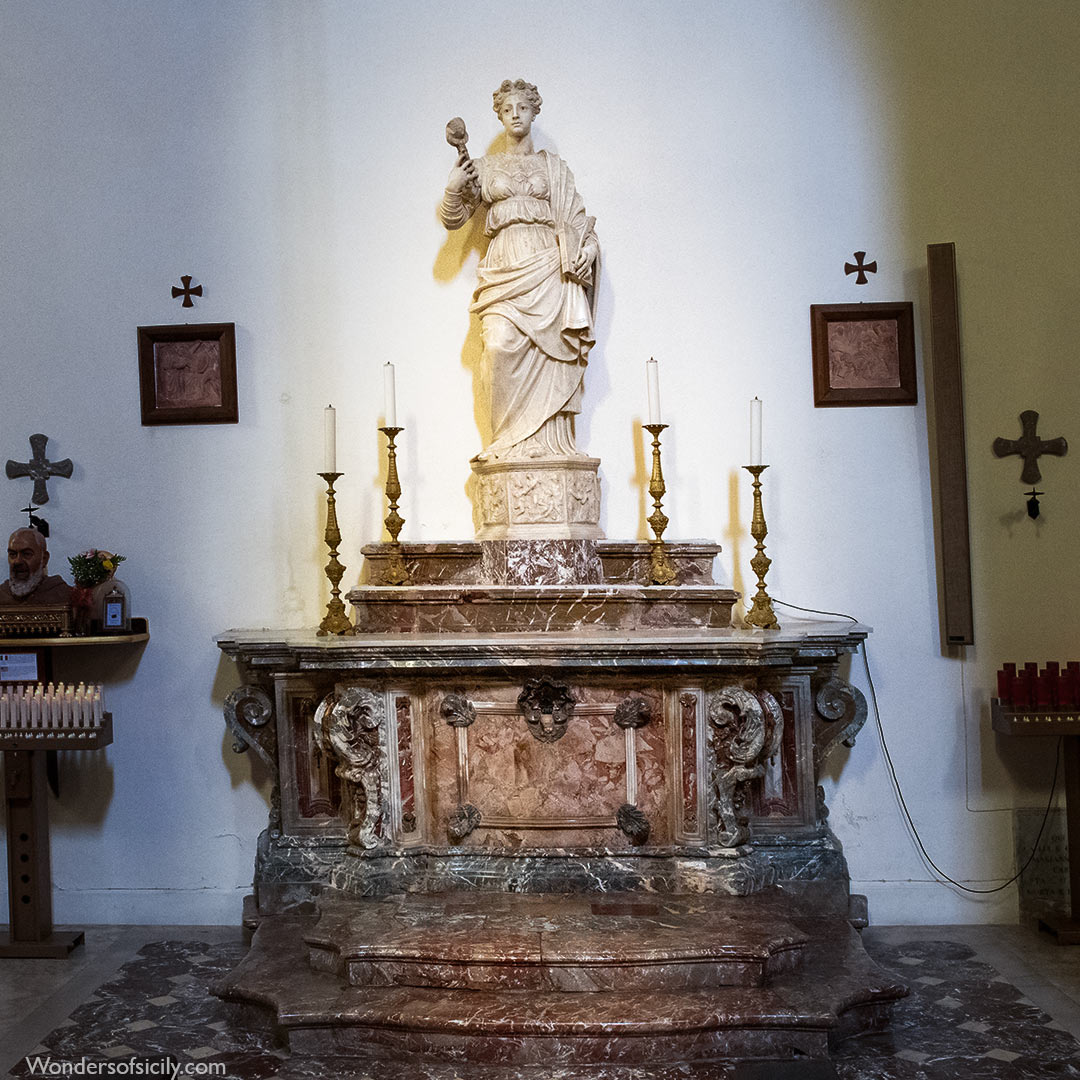
St. Agatha’s altar in the Taormina Cathedral.
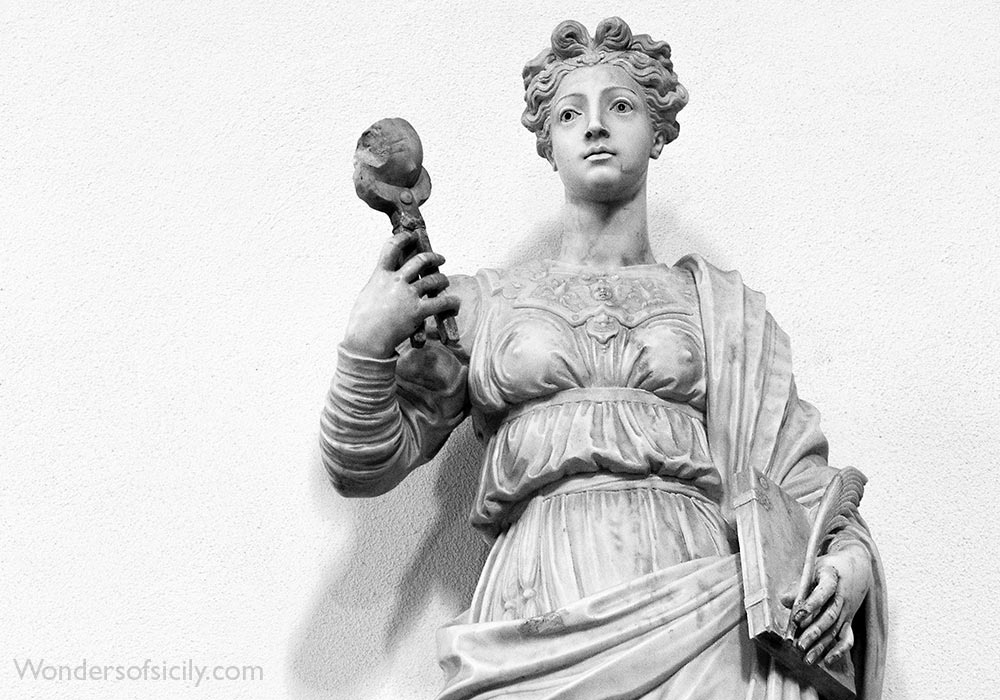
16th-century statue of St. Agatha in the Taormina Cathedral.
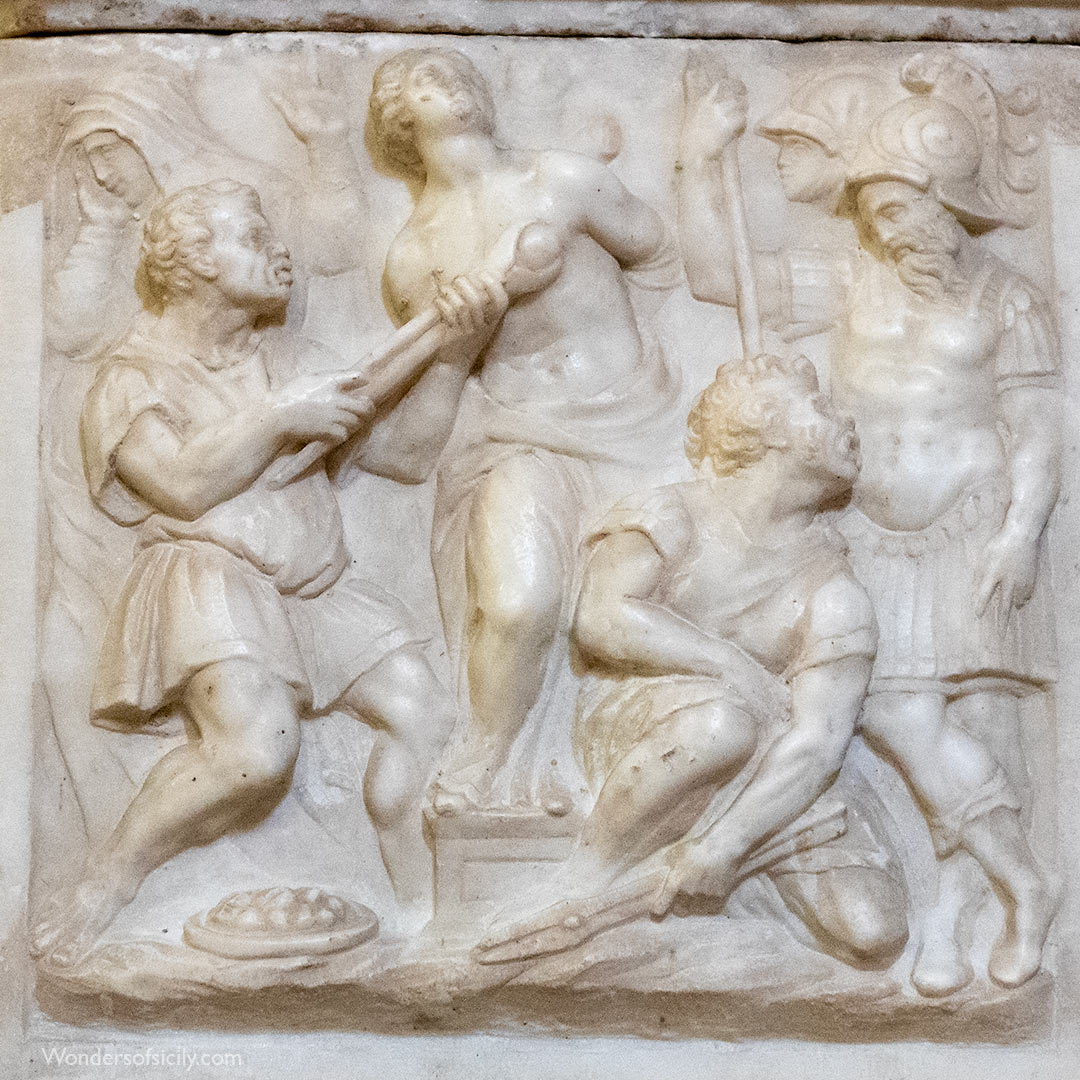
Detail of a panel at the base of the statue of St. Agatha, depicting her torture and mastectomy (the term for the removal of one or both breasts).
The Church of San Giuseppe
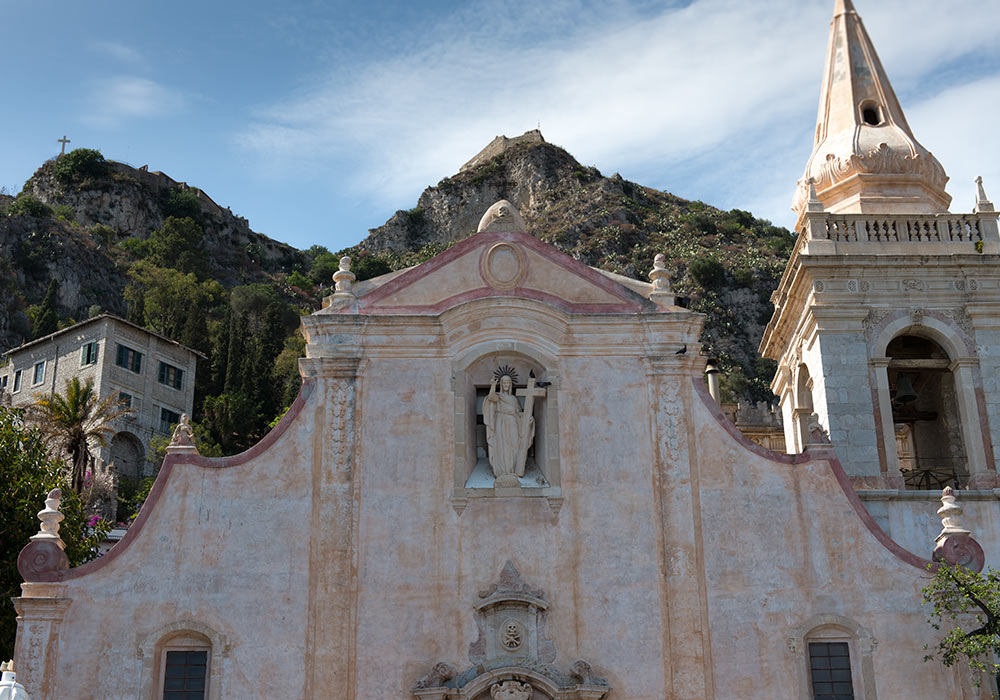
The church of San Giuseppe (piazza IX Aprile on Corso Umberto), Taormina.
On top of the mountain: the Saracen castle (Castello Saraceno); to the left: the Crucifix in front of the tiny church of the Madonna della Rocca, which is carved into the rock. The crucifix was erected in 1743 by the grateful population when an epidemic of plague passed them by.
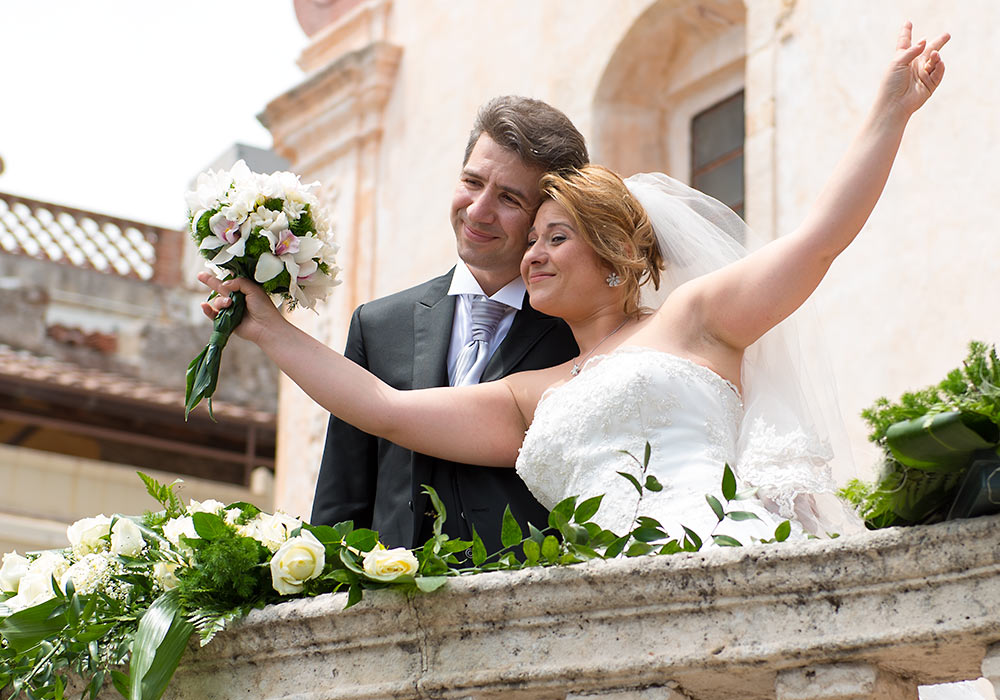
See wedding photos from Sicily here!
The Church of Sant'Antonio Abate
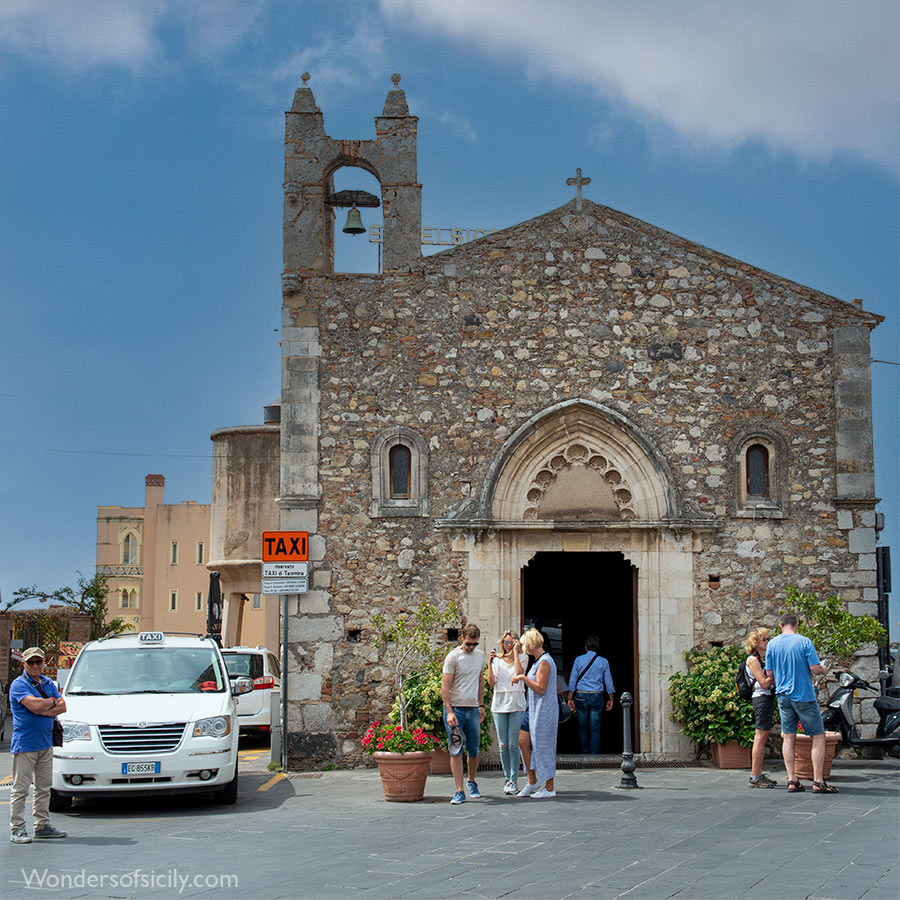
The small 14th century church of Sant'Antonio Abate is situated close to Hotel Excelsior Palace and Porta Catania. It is restored after being damaged in an air raid in 1943. The portal is Gothic.
The Church of Santa Caterina
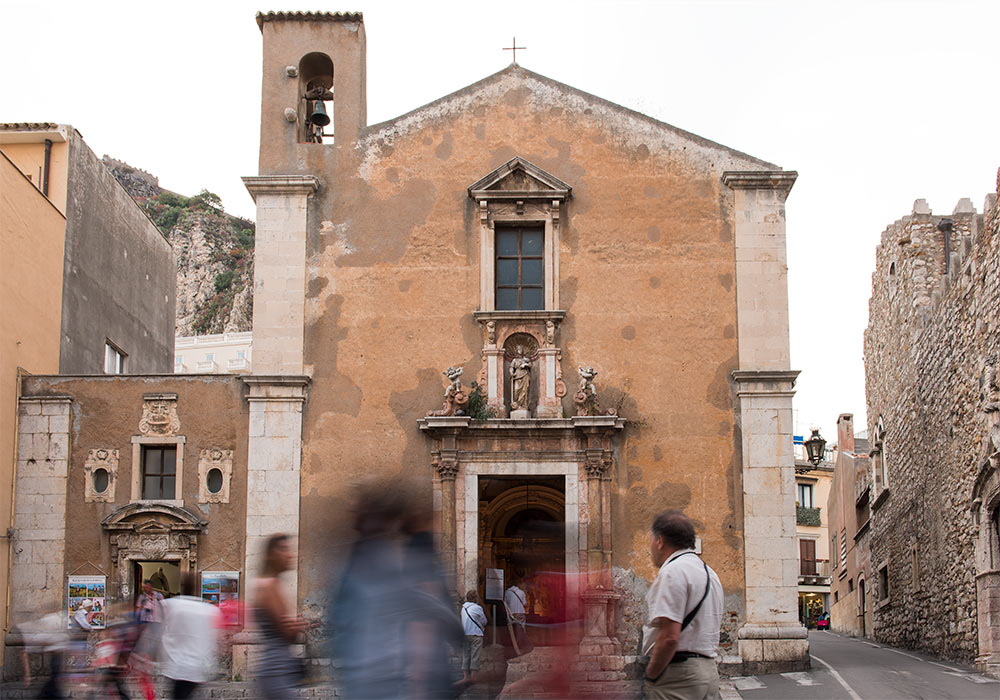
The Church of Santa Caterina (17th century). To the right, Palazzo Corvaja (early 15th century), which housed an Andy Warhol exhibition when this photo was taken (May 2015).
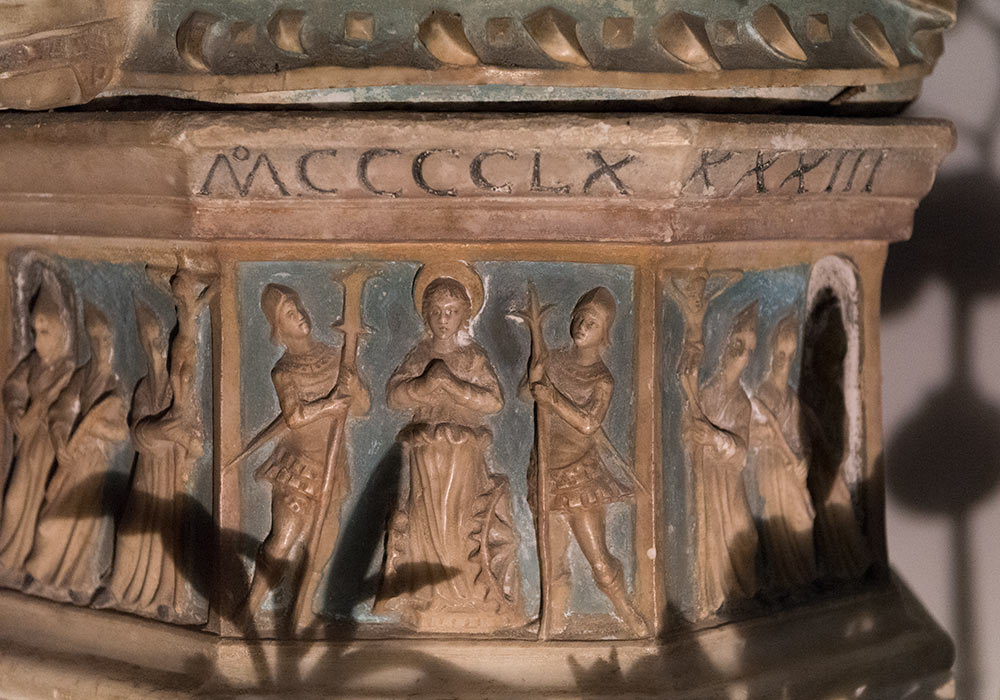
In the Church of Santa Caterina, a 15th century marble statue of St Catherine stands on a plinth (1493) with stories of her life and martyrdom.
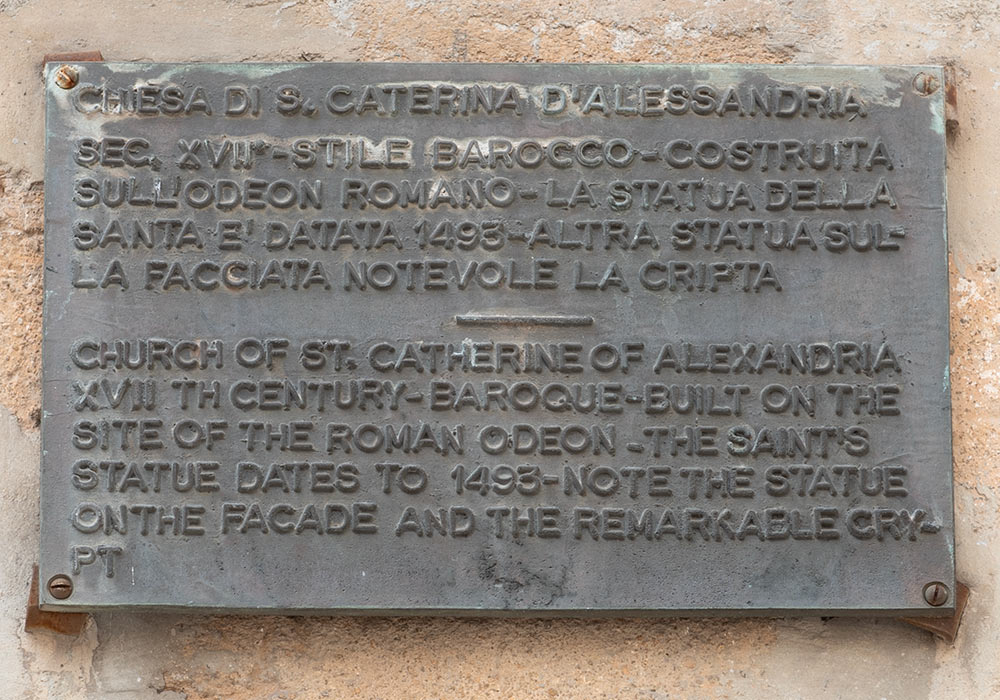
The Church of San Pancrazio (Chiesa di San Pancrazio)
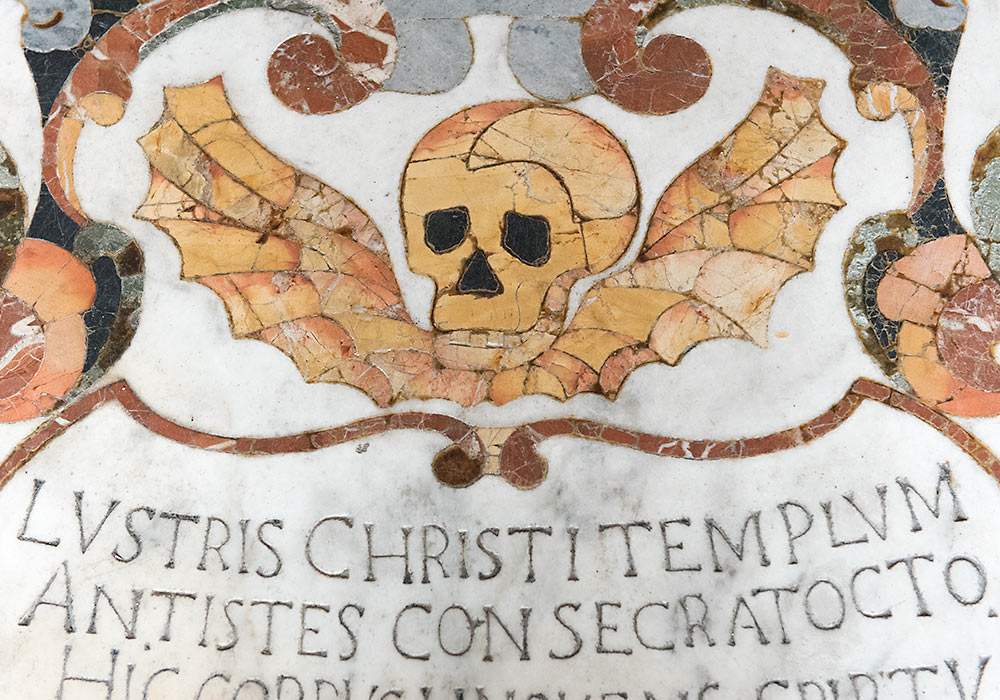
Detail of marble tomb (anno 1697) in the floor in the Church of San Pancrazio, Taormina.
Saint Pancras (aka Pancratius / San Pancrazio) is the patron saint of Taormina.
Pray for me, a poor sinner. Detail of a grave in the Church of St. Pancrazio.
Church of the Madonna della Rocca
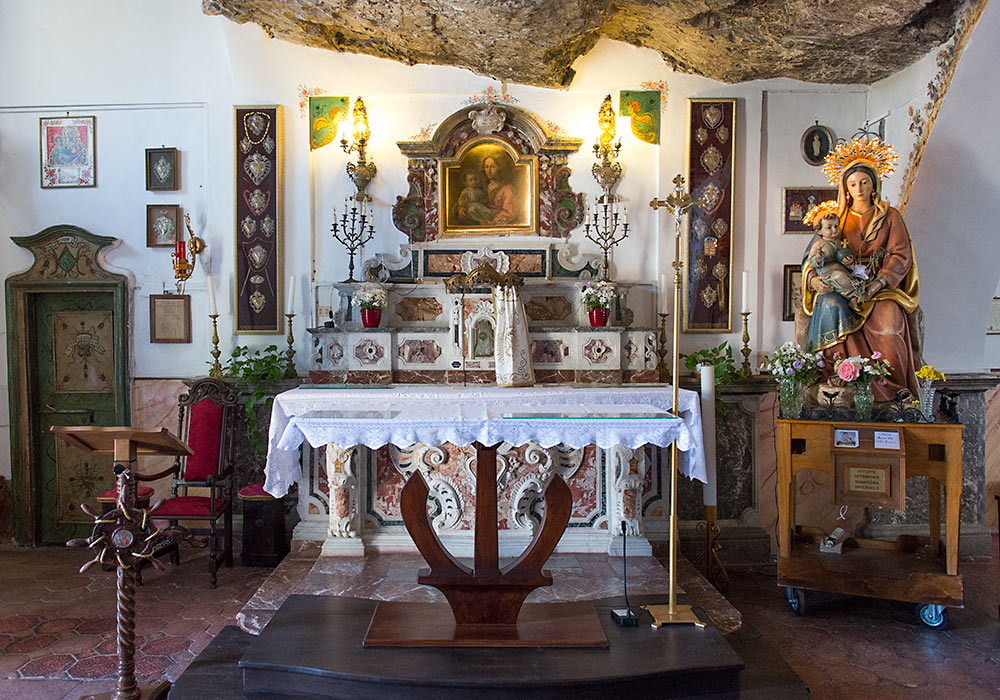
Interior of the church Madonna della Rocca, carved into the rock, above Taormina.
Castelmola
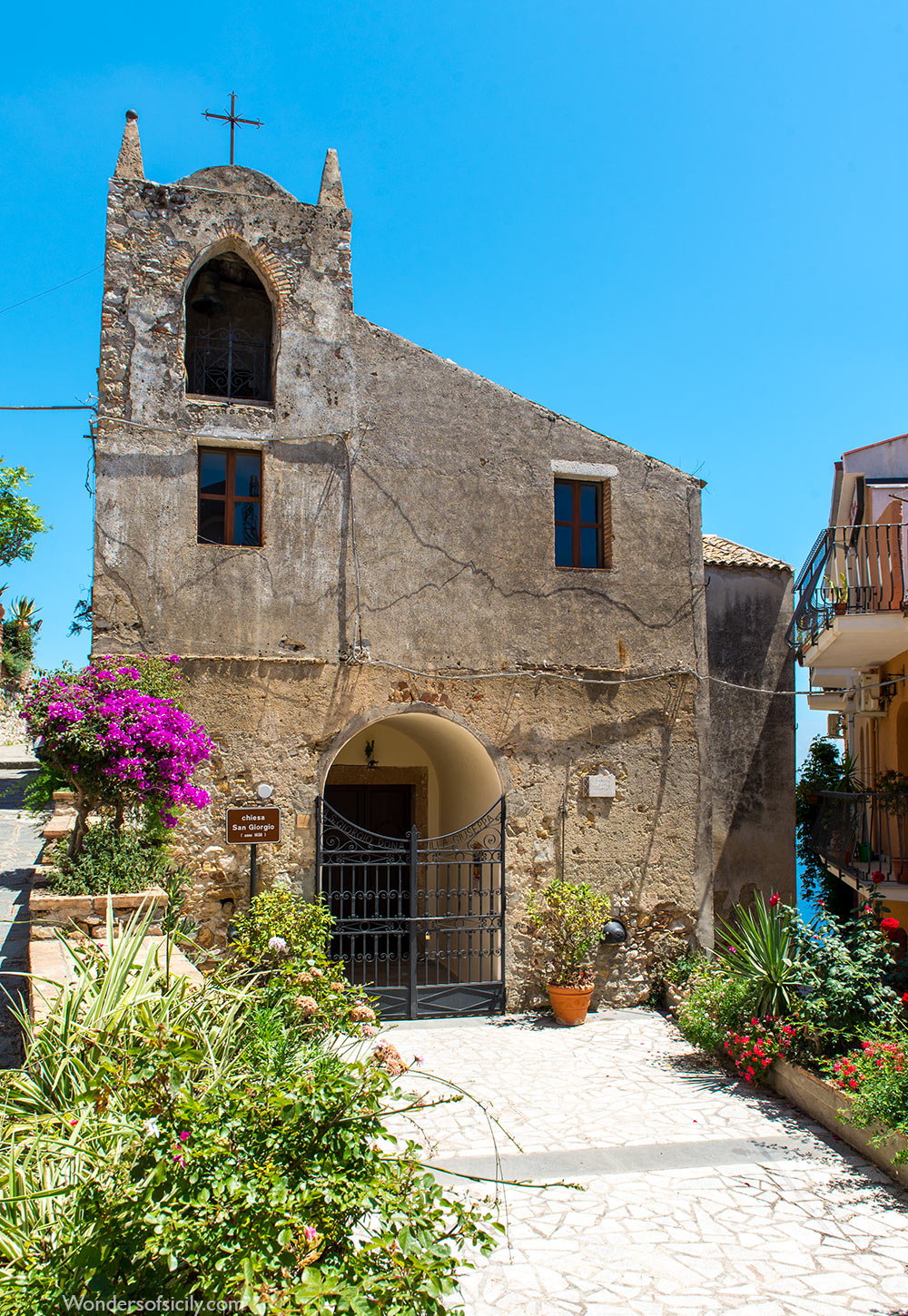
Chiesa San Giorgio, Castelmola (1450, according to the sign outside the church).
Gibilmanna
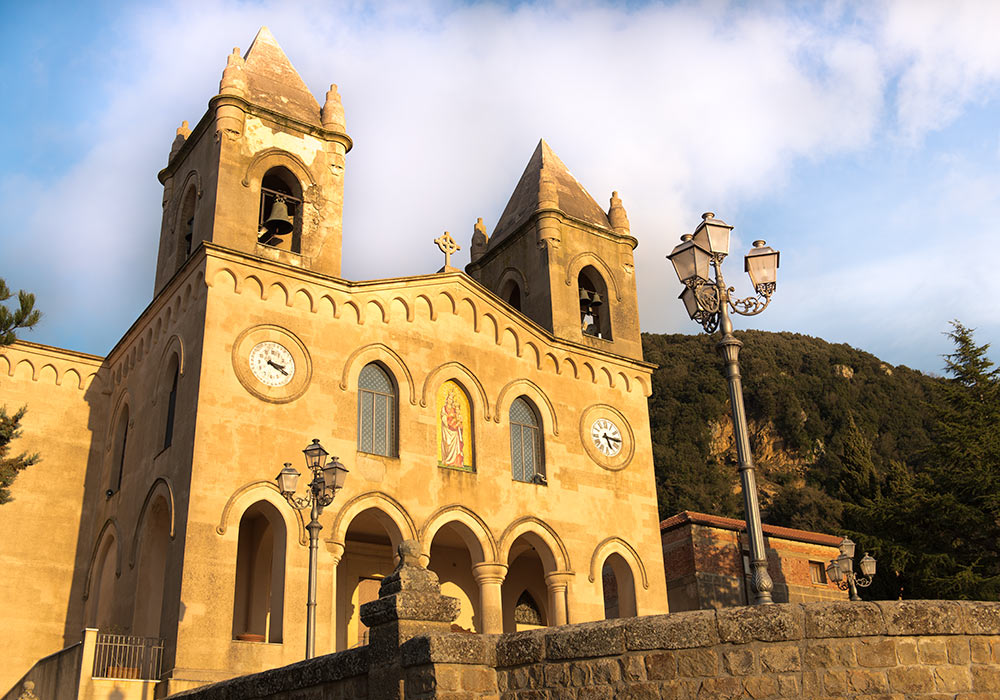
The Sanctuary of Gibilmanna bathing in the evening sun.
Trapani
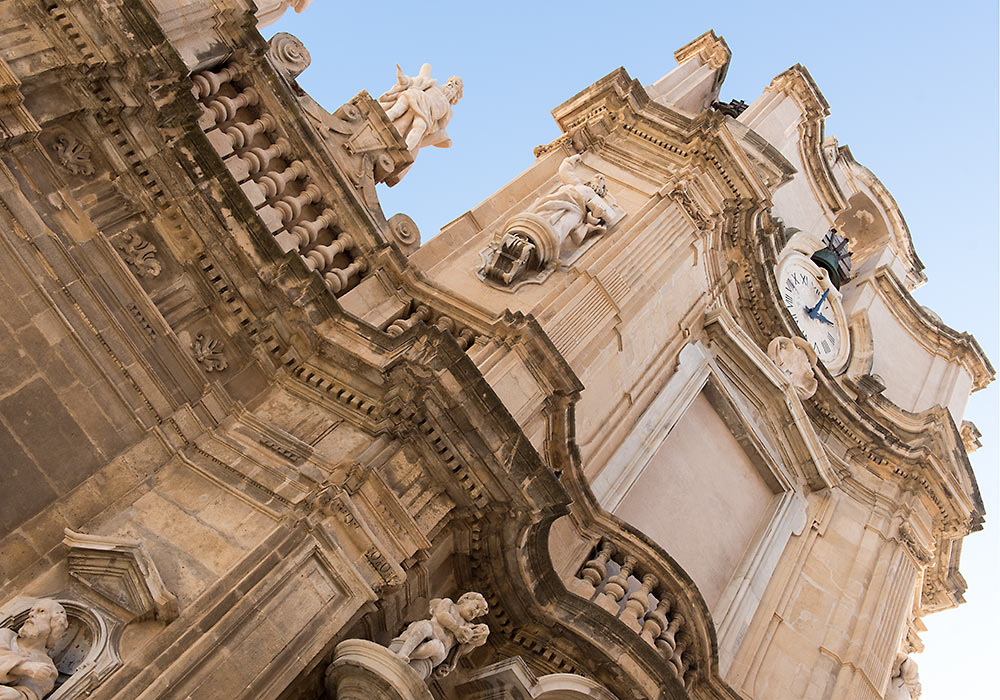
The elaborate facade of La chiesa delle Anime del Purgatorio (Church of the Souls in the Purgatory), one of the many baroque 18th century churches in Trapani. The facade was made by Giovanni Biagio Amico.
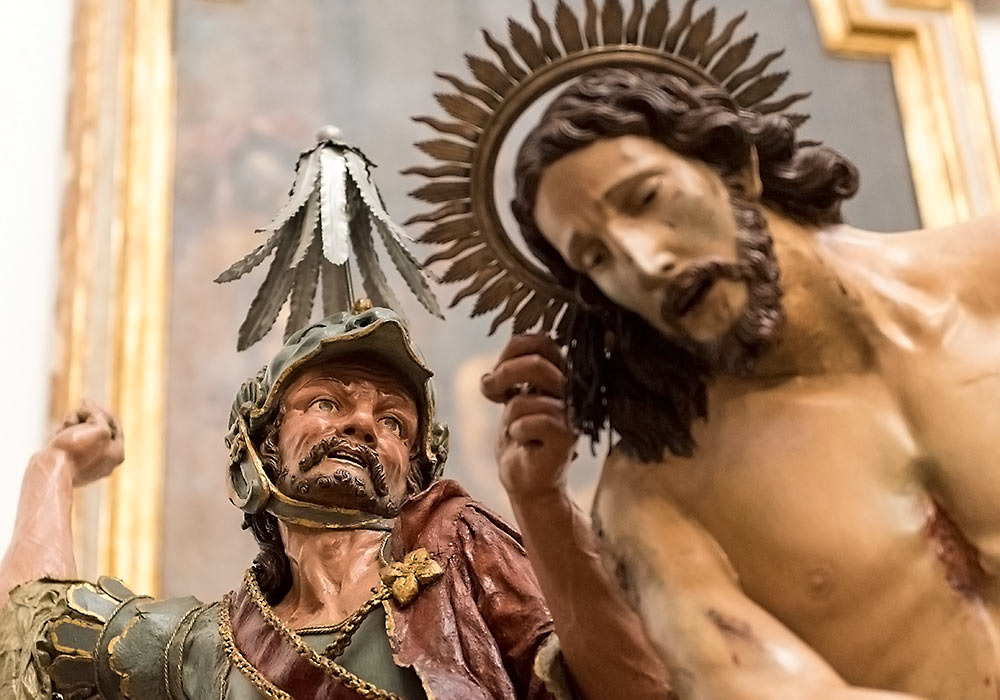
La flagellazione: The flagellation of Christ (detail), one of the many sculptures used in the "Misteri" processions on Good Friday in Trapani. The sculptures are kept in the Chiesa delle Anime del Purgatorio (Church of the Souls in the Purgatory).
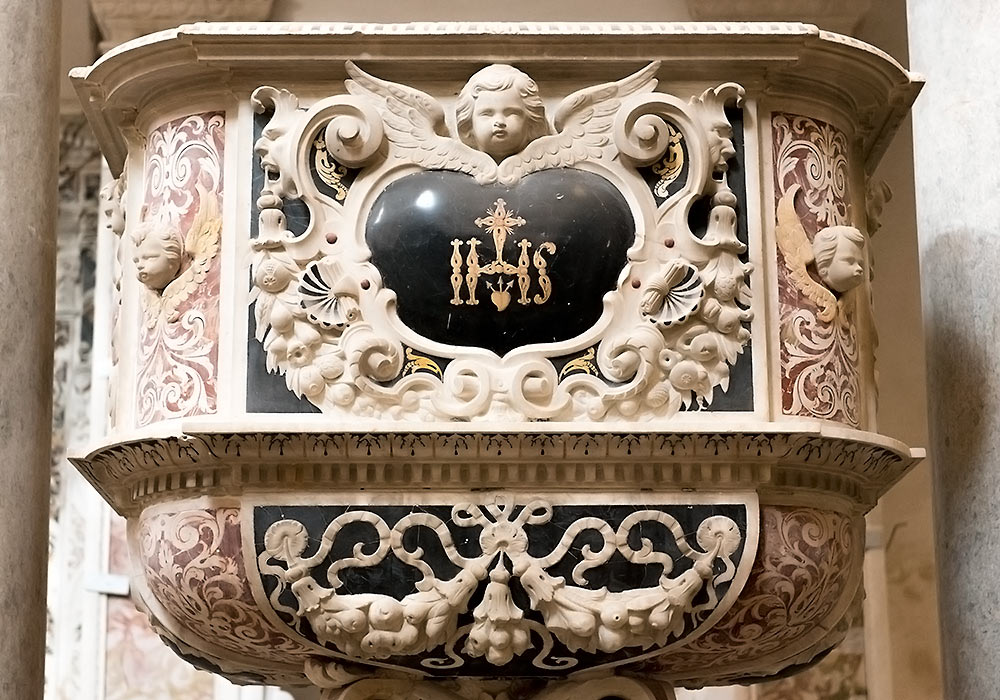
Pulpit in the Chiesa del Collegio dei Gesuiti, Trapani.
Modica
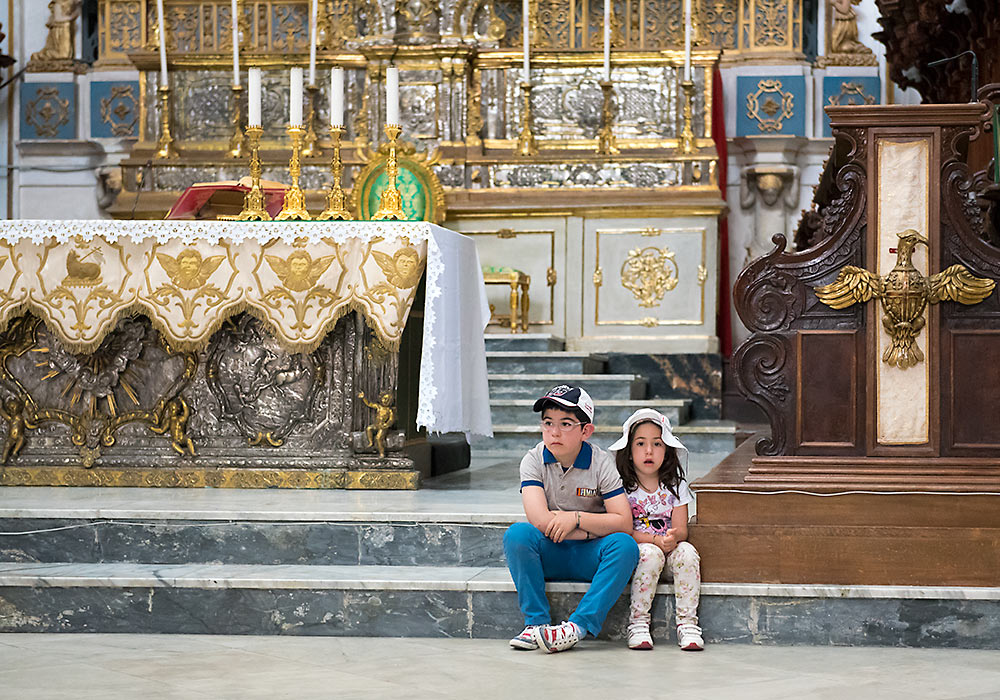
Children waiting in the Modica Cathedral.
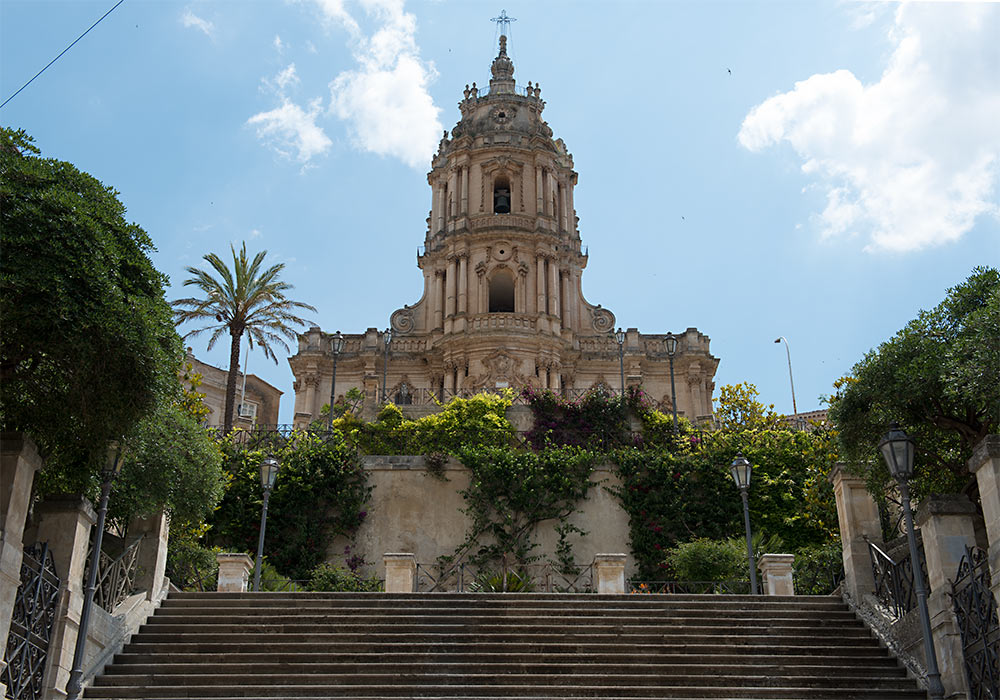
The cathedral in Modica.
Ragusa
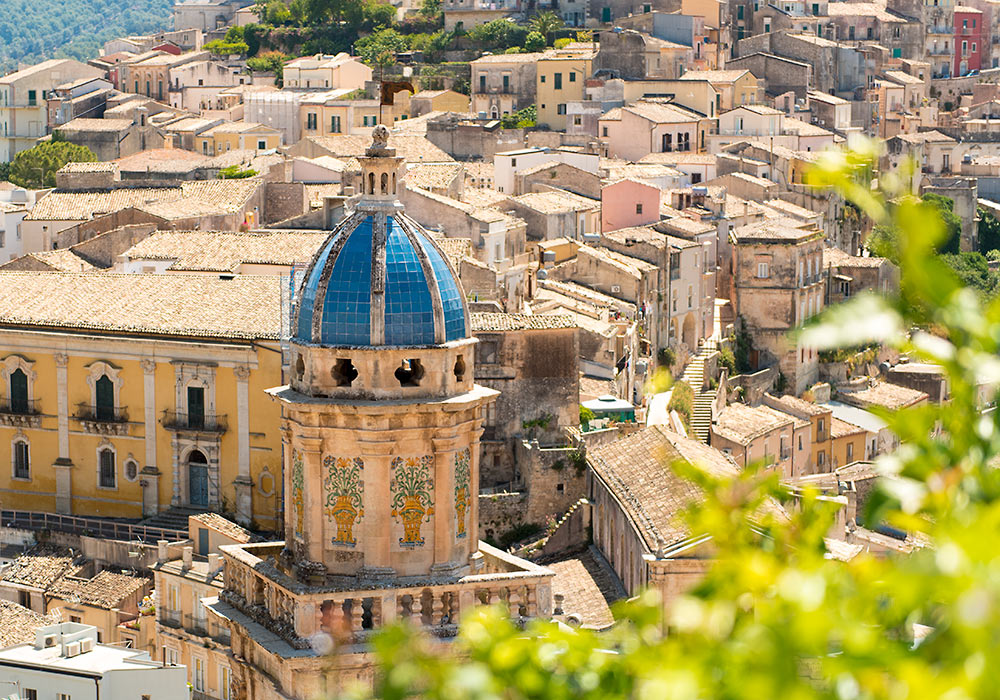
Chiesa di Santa Maria dell'Itria with its restored campanile. Ragusa Ibla viewed from Ragusa Superiore.
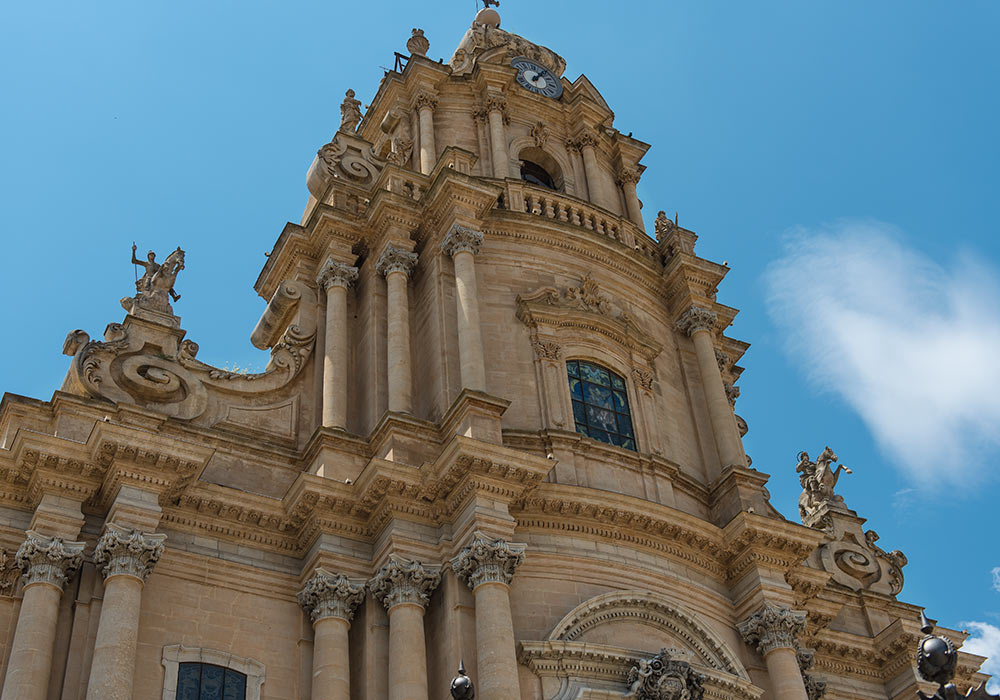
Duomo di San Giorgio (the cathedral), designed by Rosario Gagliardi. Built 1744-1775
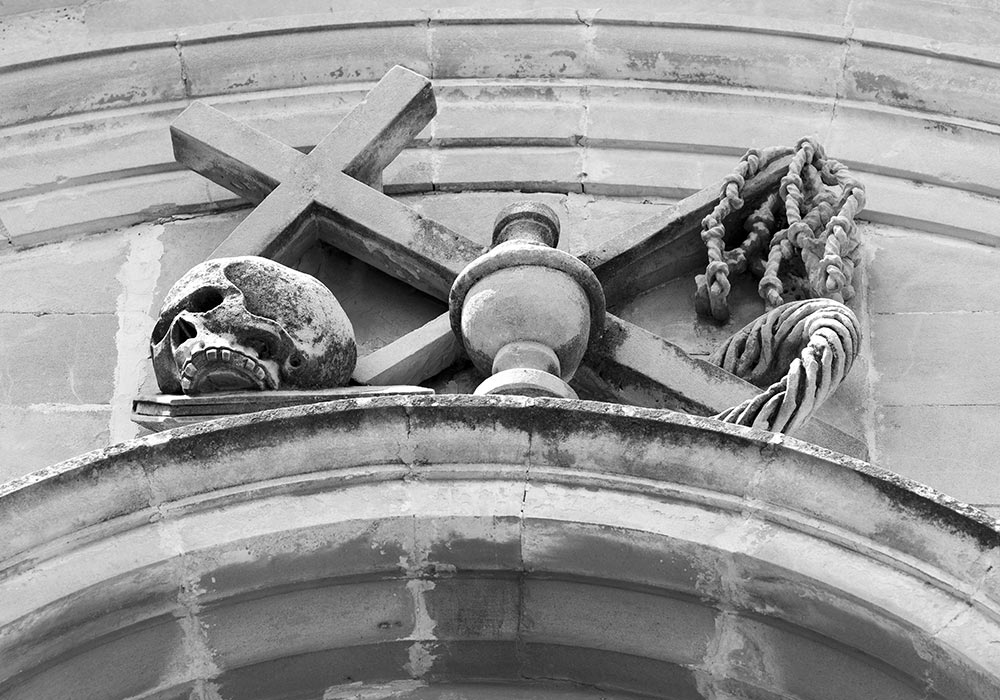
Memento mori. Decoration over the entrance of Chiesa della Maddalena (church of Santa Maria Maddalena), Ragusa, first built in the seventeenth century and later re-built (18th century).
Caccamo
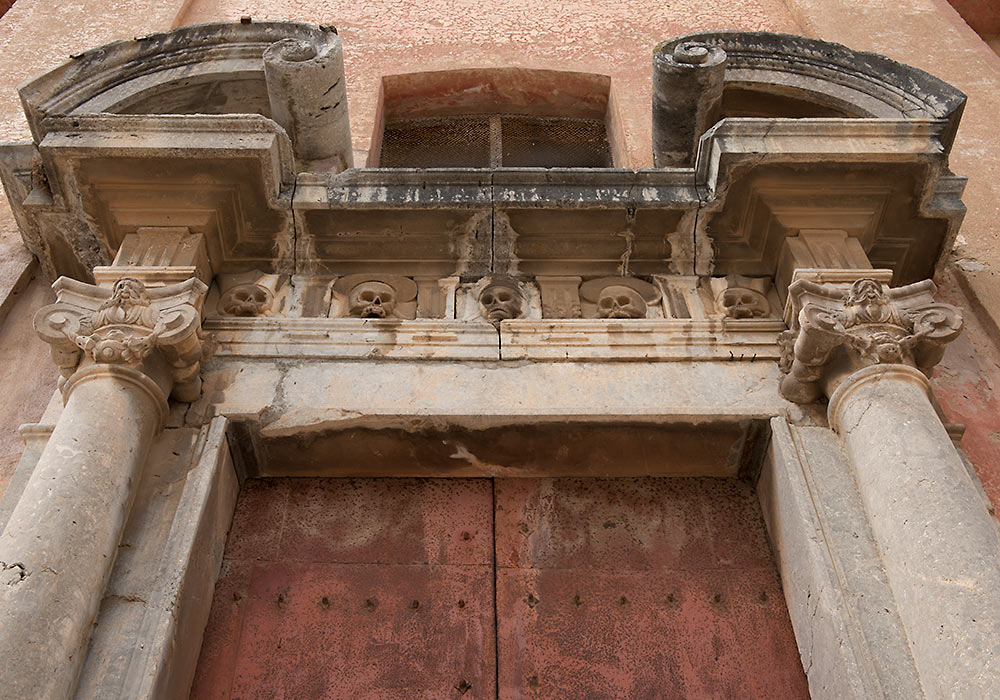
Chiesa dell'Anime del Purgatorio (Church of the Souls of Purgatory), Caccamo.
Timeline Church Art in Sicily (to be expanded…)
1564-1633: Casa Professa, Palermo, is the first church to be erected by the Jesuits in Sicily.
1640: The large church of San Domenico in Piazza San Domenico was rebuilt (the facade came 1726)
1693: On 11 January 1693 Sicily was struck by an earthquake destroying more than 70 cities and killing 60.000 people. As a result of the earthquake, whole cities had to be rebuilt.
1695: The Bavarian-baroque facade of the church of Santa Lucia alla Badia (La chiesa di Santa Lucia alla Badia, Siracusa) was made by Luciano Caracciolo.
1726: The imposing facade of church of San Domenico in Piazza San Domenico was made in 1726.
1744-1775: Duomo di San Giorgio (the cathedral in Ragusa), designed by Rosario Gagliardi, was built.
Related links
- Depictions of Jesus (as Christ Pantocrator) in Sicily
- The Monreale Cathedral
- The Cefalù Cathedral
- Mosaics in Sicily
- Churches in Sicily
Links
Alesa Arconidea - Aleister Crowley in Cefalù - Bagheria - Balconies in Sicily - Baron Wilhelm von Gloeden - Baroque architecture in Sicily - Birds in Sicily - Caccamo - cars in Sicily - Castelmola - Cats in Italy - Collesano - Death in Sicily - Death in Sardinia - Entella - Film locations in Sicily - Fish, fishermen and fish markets in Sicily - Gela - Gibilmanna - Greeks in Sicily - Halaesa Arconidea - insects in Sicily - Linguaglossa - Lizards in Sicily - Maps of Sicily - Monreale Cathedral - Monreale Cloister - Life in Sicily - Mosaics in Sicily - Mount Etna - Museums and Exhibitions - Normans in Sicily - Palermo: Museum of the Holy Inquisition - Palermo: the Norman Palace - Palermo: Oratorio del SS. Rosario, San Domenico - Palermo: the Palatine Chapel (Cappella Palatina) - Palermo: Richard Wagner in Sicily - Palermo: La Zisa - Palermo: Chiesa Santa Maria della Catena (Church of Saint Mary of the Chain) - Syracuse: The Archeological Park - Tommaso Fazello - Tuna fishing in Sicily (La Mattanza) - Videos - Villa Palagonia (Bagheria) "The Villa of Monsters" (Villa dei Mostri) - Villa Romana del Casale (near Piazza Armerina) - Sicily in Art - Sicilian Art and Artists - The White Lotus season 2 locations in Sicily -
Saint Venantius (Italian: Venanzio) was born around 235 (?) in Camerino near Ancona in the Marche region of Italy. There are no reliable accounts of his life and deeds, but according to legend, he was beheaded around 250 [247?] during the persecutions under Emperor Decius (249–51) in Camerino, at the age of 15 [17?], after enduring brutal torture. He was scourged, burned with torches, hung upside down over a fire, had his teeth knocked out, his jaw broken, was thrown to lions that merely licked his feet, and finally cast off a high cliff before being beheaded. It is likely that he was a martyr whose relics were transferred to Rome by Pope John IV (640–43). A cult quickly developed around him, spreading to various regions, including the city of Camerino in Marche di Ancona, where he became the city's patron saint. The Church of San Venanzio still stands in Camerino. It is claimed that a sanctuary dedicated to Venantius existed in Camerino as early as the 5th century, supporting another legend that he was a young man from Camerino who was martyred by beheading around 250 during Emperor Decius' persecution of Christians. His feast day is May 18. Pope Clement X (1670–76), himself a former bishop of Camerino, elevated Venantius' feast day to a double rank (as the terminology of the time described it) and composed hymns for his office. However, in 1969, his feast was removed from the Church’s universal calendar and assigned to regional and particular calendars. Due to the extensive and long-standing veneration of Venantius in Italy, many depictions of him exist. He is portrayed as a young man holding a banner and a city wall. Sometimes, he is shown holding the fortress of Camerino or the city itself, along with a palm and a book. He may also be depicted crucified upside down, with smoke rising from his head. He is often confused with Terentianus, another young man shown holding the citadel of Pesaro.

